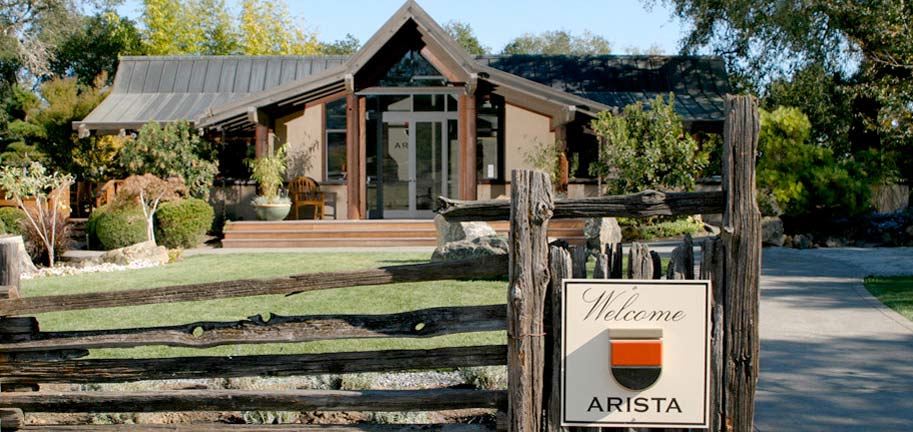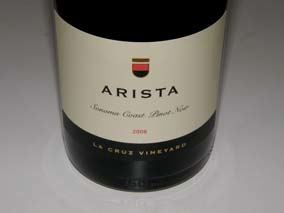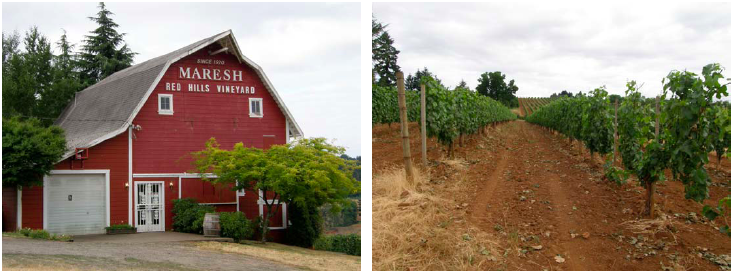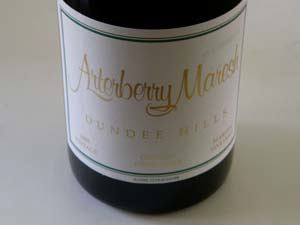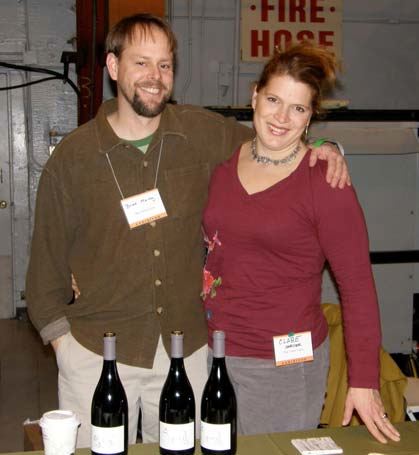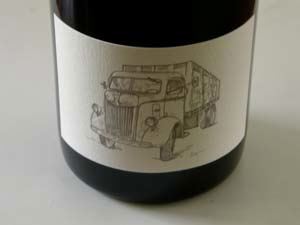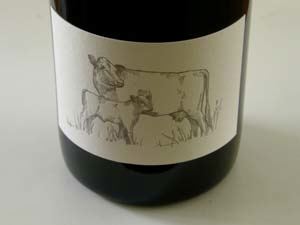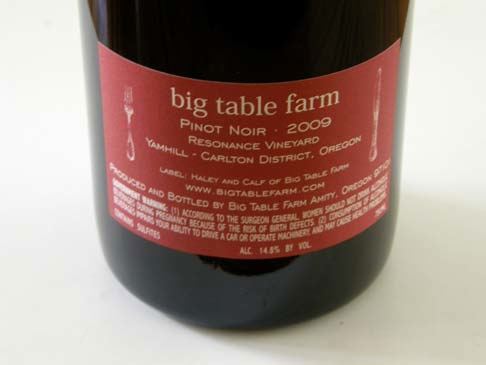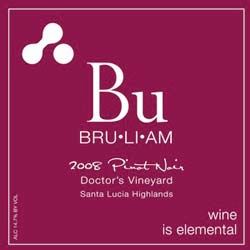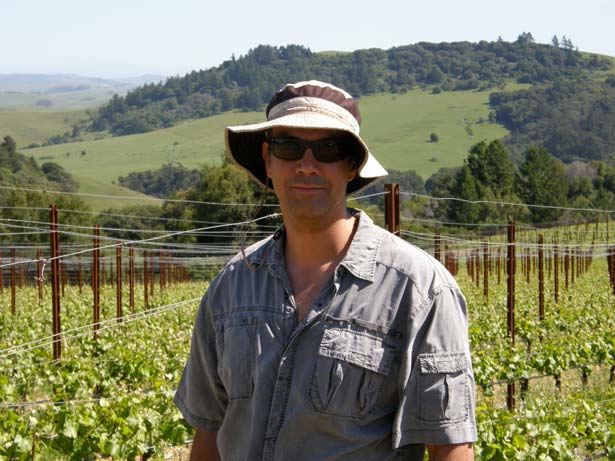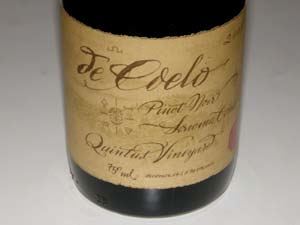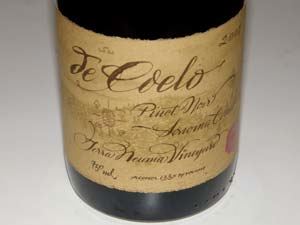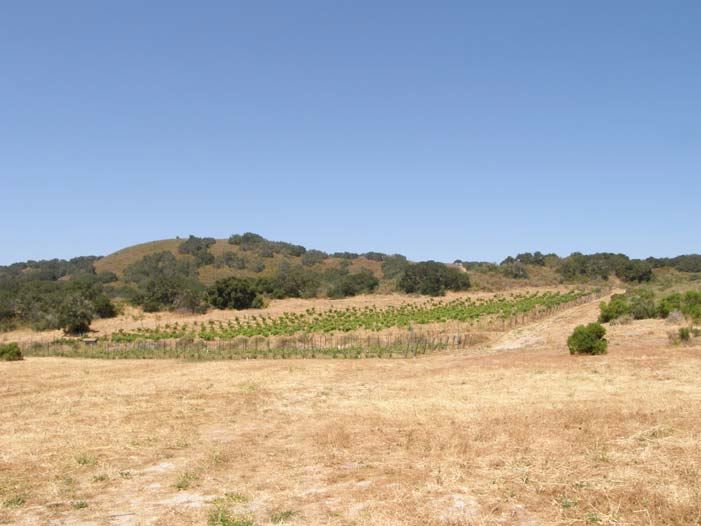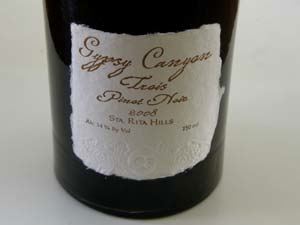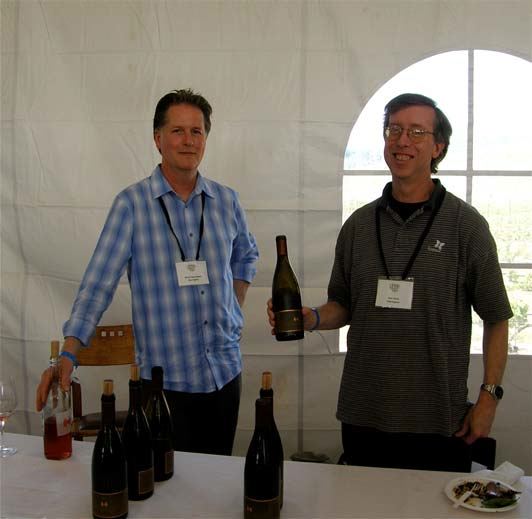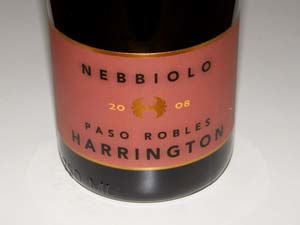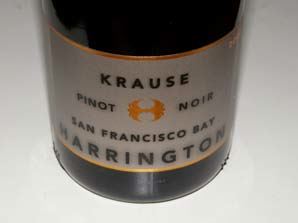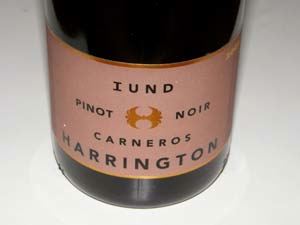PinotFile: 8.27 December 14, 2010
|
Drinking SmallWine publications and promotional material from wineries would have you believe that small case production of Pinot Noir translates to better quality. This claim has some truth to it as Pinot Noir does not lend itself to the large production winemaking techniques used in crafting other red wine varietals. Most cracking North American Pinot Noirs are hand-crafted in less than 500 case quantities, even less than 100 cases, much like the great wines of Burgundy. However, small production is labor intensive and often results in high prices ($40 and above), and is no guarantee that the wine will be a winner. Like Burgundy, it is most critical to know the producer when choosing a Pinot Noir wine. One can then look to appellations or specific vineyards that possess the terroir to capture your attention. Acquiring knowledge of Pinot Noir and its producers is a lifelong hobby. Today, there are more American wineries making Pinot Noir than any other red variety. There are well over 1,200 wineries in California and Oregon crafting this righteous juice, most of which are very small, family owned, boutique operations. Small production creates a challenge to source and acquire the good stuff, but the journey is filled with anticipation and surprises. As a devoted Pinot Pimp, and champion of the accomplished small guy, I am happy to lead those of you with a glint of Pinot Noir in your eye on your adventure. You can begin with this issue, filled with marvelous wines from sixteen small California and Oregon wineries. Get crackin.
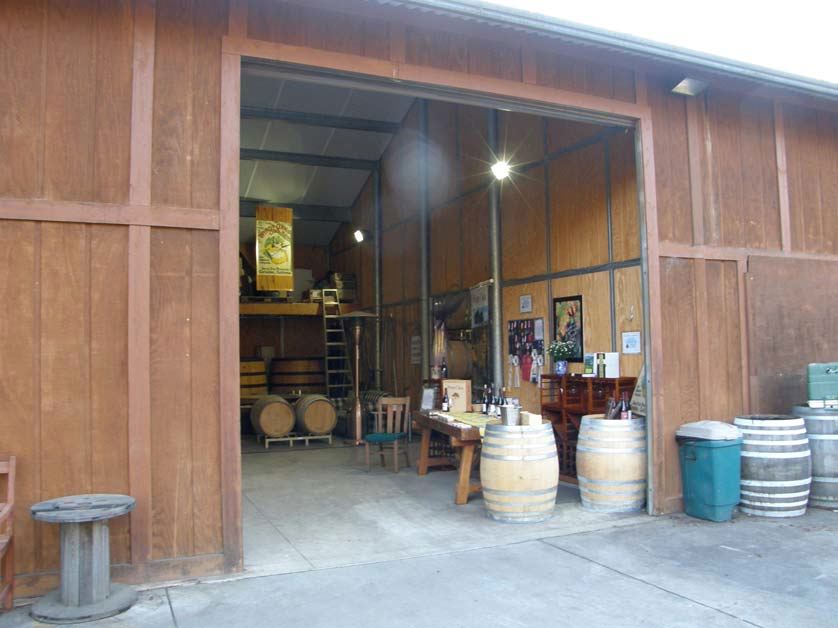
Arista Winery is one of the new bright stars on Westside Road in the Middle Reach sub-region of the Russian
River Valley. The estate consists of 36 acres that was originally a part of a Southern Pomo Indian village
named Budutcilan. In the mid 1800s, the area was a prime growing site for the lumbar industry and later for
hops. The McWilliams family acquired the property in 2004 and in mid 2005 the Arista Estate was opened to
the public.
Arista winery is a small, family operated affair. The patriarch is Al McWilliams, a former orthodontist who had
previously farmed Pine Mountain Vineyards in the Alexander Valley with brother-in-law John Copeland. The
McWilliams could not use their family name for their Russian River Valley winery since E. & J. Gallo owned a
similarly named winery in Australia. The letter sent to the McWilliams family from the E. & J. Gallo attorney
suggested two alternative names and Arista was chosen.
Currently, Arista sources Pinot Noir from several Sonoma County vineyards. 10 acres of high density vines
have been planted on the estate property by vineyard manager Ulises Valdez, and a Pinot Noir from the site
will be produced beginning in 2010. Ben McWilliams directs vineyard development and oversees grower
relations. Plans are afoot to soon build a winery on the estate property. The winemakers are veteran Leslie
Sisneros, a University of California at Davis graduate who crafted Pinot Noir for Kendall Jackson Wine Estates
for thirteen years, and young Mark McWilliams. Mark developed a passion for wine fresh out of college
working for Kendall Jackson Wine Estates leading to his interest in winemaking. Besides assisting Sisneros,
he manages the day to day operations of the winery.
The emphasis at Arista Winery is on vineyard-designated wines including Pinot Noir, Zinfandel, Pinot Gris, and
Gewürztraminer, all produced in lots of 80 to 300 cases. The wines have been very favorably reviewed in the
wine press, and as a result, the mailing list of customers has become crowded, but is still open to newcomers.
The single vineyard wines are only available to mailing list members. Some of the larger production appellation
wines are sold online, distributed to retail wine stores and offered in small amounts in the tasting room. The
winery was not included in John Winthrop Haeger’s comprehensive book, Pacific Pinot Noir, (published in 2008
and not on Haeger’s radar yet), but as the Pinot Noirs reviewed below from the 2008 vintage demonstrate, this
producer definitely deserves your attention. The wines all displayed admirable balance, a sign of impeccable
winemaking.
The winery’s beautiful tasting room is surrounded by a serene, Japanese garden. Located at 7015 Westside
Road, visitors are welcomed daily from 11-5. The venue is available for weddings, corporate meetings and
other special occasions. The winery’s website is www.aristawinery.com and phone is 707-473-0606. The
winery is currently offering a “Taste of Arista” gift box, which includes six 50 ml tasting bottles of 2008 Arista
wines ($35), a unique way to sample several wines before buying.
2008 Arista Russian River Valley Pinot Noir
14.3% alc., pH 3.80, 616 cases, $44. Released spring 2010.
Aged in 40% new French oak barrels. 92% Russian River Valley, 8% Sonoma Coast.
·
Shy aromas of black
cherries and red berries picking up some intensity over time in the glass. Earth-kissed black cherry and berry
flavors with a slight oak and tobacco edge. On the lean side, but has some charming silkiness on the palate.
A reliable daily drinker. Decent.
2008 Arista Longbow Russian River Valley Pinot Noir
14.5% alc., pH 3.80, 430 cases, $44. Released
spring 2010. Sold out. Aged in 65% new French oak.
·
The nose is closed for business with oak at the forefront
and only a hint of mixed purple berry and dark stone fruit peaking out over time in the glass. A mediumweighted
fruit-driven wine with flavors of black cherries, black currants and plums veering to the ripe side with
oak in the background. Silky smooth with mild tannins. Needs more time. Tasted twice. Good.
2008 Arista Sonoma Coast Pinot Noir
14.3% alc., pH 3.80, 920 cases, $34.
Released spring 2010. Aged in 12% new French oak, 24% 1 year oak and 64%
seasoned oak.
·
The vibrant aromas of dark berries and cherries, oak and
mushroom really grab your attention. Tasty core of berries and plums with a
sidecar of tea and earth flavors. The fruit flavors have impressive intensity and
persistence, and the silky texture adds to the appeal. This is a wine that grabs
your senses and holds on. Good.
2008 Arista Bacigalupi Vineyard Russian River Valley Pinot Noir
14.4% alc., pH 3.52, 220 cases, $56.
Released fall 2010. Helen and Charles Bacigalupi’s first plantings in the Middle Reach of the Russian River
Valley date from the early 1960s. Carl Wente sold the Bacigalupi family Pinot Noir cuttings from his vineyard in
the Livermore Valley. This wine contains the old Wente Selection Pinot Noir and Pommard clone from this
historic vineyard. Aged in 50% new French oak barrels.
·
Moderately light reddish-purple color in the glass.
Demure aromas of spiced Bing cherries picking up more of a savory, leafy bent over time in the glass. Discreet
array of medium-weighted dark red Pinot fruit flavors with notes of herbs and mushroom. A relatively simple
and youthful wine now, but with impeccably balanced tannins and acidity, should age nicely in the bottle.
Good.
2008 Arista La Cruz Vineyard Sonoma Coast Pinot Noir
14.3% alc., pH 3.68, 258 cases, $56.
Released fall 2010. From the southernmost end of the Sonoma Coast appellation. Plantings here were
among the first in the Petaluma Valley dating to 1994. Aged in 50% new French oak barrels.
·
Seductive
aromas of fresh black cherries with hints of oak and spice box. A gorgeous wine in the mouth with bright
flavors of black cherry and black raspberry with a complimentary underpinning of oak spice and toast.
Perfect harmony creating a wine that urges you to take another sip. I would love some duck confit with
this beauty.
2008 Arista Mononi Vineyard Russian River Valley Pinot Noir
14.5%
alc., pH 3.63, 224 cases, $56. Released fall 2010. From a 10-year-old
vineyard planted to Dijon clones 113 and 115. Aged in 50% new French
oak barrels.
·
Stunning and nuanced aromatic profile featuring spiced
berries, rose petals and violets picking up intensity with time in the glass.
This wine has all the charm and delicacy one could asked for combined
with a tasty and hearty core of cherry, strawberry and cola flavors, harmoniously
supported by soft tannins and bright acidity. The whole package.
2008 Arista Toboni Vineyard Russian River Valley Pinot Noir
14.5% alc., pH 3.63, 256 cases, $56. Released fall 2010. This 15-acre vineyard is located just off Olivet Lane and is planted to Dijon 115, 667, 777 and Pommard 5 clones. Aged in 50% new French oak barrels.
·
Brooding nose with scents of dark fruits, raisin and cigar box. The most intensely fruity and tannic wine in the Arista lineup but retaining an appealing silky mouth feel. The berry, cassis, and plum flavors veer to the ripe and sweet side with oak char providing a backup note. Not shy, and quite flavorful. Very Good
The Maresh family is closely tied to the history of Pinot Noir in the Williamette Valley. Jim and Loie Maresh
were Wisconsin natives who met as students at Marquette University. The couple bought a 26-acre farm in the
Dundee Hills in 1959. They expanded their holdings while Jim worked for Dunn & Brandstreet and served as a
reserve officer in the Navy in Portland. Their home was relatively isolated, but they enjoyed the life of farming
cherries, nuts and prunes.
Dick Erath, who had begun to farm 49-acre vineyard in the Chehalem Mountains in 1968, encouraged the
Maresh family to grow wine grapes on their site. They followed his suggestion and in 1970 planted three acres
of Pinot Noir vines. At the time, David Lett (The Eyrie Vineyards) had the only Pinot Noir vineyard in Yamhill
County. The Maresh Vineyard was the fifth to be planted in Oregon and the first vineyard developed on Worden
Hill Road outside of Dundee, now a major epicenter of Pinot Noir in the Willamette Valley.
Jim and Loie had five children. One daughter, Martha, married Fred Arterberry who was one of the first Oregon
winemakers to have a degree from the University of California at Davis. Arterberry produced many award winning
wines including the first sparkling wine in Oregon. Fred Arterberry’s 1985 Pinot Noir received a 95
point score from Wine Spectator and was Oregon’s highest scoring Pinot Noir for more than twenty years.
Martha and Jim had a son, Jim Arterberry Maresh. When the eldest Jim died, Martha remarried but kept
Maresh as her last name.
The Maresh Estate now consists of 124 acres of several varieties including Pinot Noir and Chardonnay. The
vineyard is primarily south west facing and is planted on Jory soil at 850 feet above sea level. The
southwestern exposure allows for perfect ripening and the old vines contribute a depth of flavor and complexity
that is matched by few other Pinot Noir vineyards in Oregon. The vineyard is managed by Stirling Fox. About
50% of the grapes (600 cases) are vinified as Red Barn Pinot Noir and sold only through the Red Barn tasting
room. The rest of the grapes are highly sought after and sold to Daedelus Cellars, Et Fille, Kelley Fox Wines,
Scott Paul, Sineann and Arterberry Maresh. Rex Hill produced a Maresh Vineyard Pinot Noir for many years
until the winery was sold a few years back.
Jim Arterberry Maresh is one of Oregon’s young hounds in the Pinot race. Jim began “messing around”
making wine in 2001, apprenticed at Penner Ash in 2003, St. Innocent in 2004 and Cameron in 2005. In 2007
he revived his father’s label, Arterberry Cellars, as Arterberry Maresh, releasing his inaugural wines with much
fanfare from the 2005 vintage. The label is true to that of Arterberry Cellars, modified only slightly to include the
Maresh name. The 2006 vintage Pinot Noirs were particularly impressive. The 2006 and 2007 Arterberry
Maresh Pinot Noirs have been reviewed previously in the PinotFile and a 2008 release is detailed below.
The Arterberry Maresh Pinot Noirs are sold through a mailing list with limited retail distribution within Oregon.
Avalon Wine is an online source (www.avalonwine.com). The winery phone is 503-434-7689.
2008 Arterberry Maresh Maresh Vineyard Dundee Hills Willamette Valley Pinot Noir
13.5% alc., $75. Unfined and unfiltered.
·
Reluctant nose initially
offering some berry fruit, oak and a green pea note. Substantial classy core of
berry and red plum fruit with a slight green edge. Silky in the mouth with
harmonious acid and tannin interplay. Doesn’t excite upon opening but
becomes more giving the next day from a previously opened and re-corked
bottle, offering more fruit aromatically and more intense pure fruit flavors. Like
so many 2008 Pinot Noirs from Oregon, this wine needs time to come together
and may eventually titillate. Good.
Other 2008 Arterberry Maresh wines available include: Chardonnay ($75), Dundee Hills Pinot Noir ($25), and
Juliard Vineyard Pinot Noir ($50). A second label, D.H. Proth Dundee Hills Pinot Noir is a value priced, early
drinking bottling ($15 for the 2009 vintage).
This outstanding producer burst on the Oregon wine scene in 2006. A collaborative effort between winemaker
Brian Marcy and artist Clare Carver, the pair are another one of a long line of California emigrants who arrived
in the Willamette Valley to farm grapes and craft wine. The pair compliment each others' talents, with Brian the
experienced winemaker, and Clair the marketer and manager of their 70 acres in Gaston. He studied
fermentation science at University of California at Davis and apprenticed in California at Turley Wine Cellars,
Neyers Vineyards, Blankiet Estate and Marcassin, and in Australia at Trevor Jones Fine Wines. She has won
multiple awards for wine label design which adorn the wines of notable wineries like Beaux Freres, Phelps
Creek and Miner Family Vineyards.
Beyond making remarkable wines, the couple have established a working farm where they raise pigs, cows,
meat and egg-laying chickens, and have working horses. The name, “Big Table Farm,” reflects the owners’
desire to provide a welcoming table for themselves and their friends, laden with artisan foods and wine. Some
of the farm-raised animal products will eventually become available commercially.
The lineup of wines have varied each year and the 2009 Laughing Pig Pinot Noir Rosé, 2008 Willamette Valley
Pinot Noir and 2008 Resonance Vineyard Willamette Valley Pinot Noir have been previously reviewed
(www.princeofpinot.com/winery/964/). Most labels feature a drawing of a single farm animal and are quite
stylish. They are fashioned by hand using a letterpress, then cut and glued onto each bottle. Besides the
wines reviewed below, a 2009 Riesling from Brooks Estate Vineyard and a 2007 Syrah from California’s White
Hawk Vineyard are offered. A 2009 Willamette Valley blend will be released in the spring 2011.
Big Table Farm wines are sold primarily through a mailing list at www.bigtablefarm.com. The website is very
informative and one of the most modern and well-designed winery websites I have ever visited. The winery
and farm are open only by appointment (503-662-3129).
I must admit to being smitten by not only the quality of Big Table Farm wines, but the way the owners stand out
as truly personal and talented individuals with generous joie de vivre, and a commitment to sustainable farming
traditions. This is the type of small producer we want to, need to, and have to support.
2009 Big Table Farm Cattrall Brothers Vineyard Eola-Amity Hills Willamette Valley Pinot Noir
13.7% alc, 100 cases, $45. Label features a grape delivery
truck owned by the Cattrall Brothers, a 1947 Ford. From the oldest certified
organic vineyard in Oregon, planted in the 1970s. Unfined and unfiltered.
·
Moderately light reddish-purple color in the glass. Lovely aromas of cherries,
strawberries, red roses and sandalwood. Delicate but tasty core of red fruits with
strawberry flavor at the forefront and toasty oak and baking spices adding interest
in the background. A charming wine with admirable balance that is drinking
nicely now. Very Good.
2009 Big Table Farm Resonance Vineyard Yamhill-Carlton District Willamette Valley Pinot Noir
14.8% alc., 190 cases, $48. Label sports
picture of Haley the cow with first calf born at Big Table Farm spring
2010. Pommard, Wädenswil and Dijon 777 clones. Fermented with
natural yeast, some pigeage, and aged sur lie in French oak. Unfined and
unfiltered.
·
Moderately deep garnet hue in the glass. Boisterous and
alluring aromas of dark, rich Pinot fruits that just won’t quit. Delicious attack of
dark berry jam with ever changing additional layers of flavor that include anise,
lavender and Asian spice. This is a wine of discovery, revealing more interest
with each sip. The tannins are reigned in making for approachability now and
the succulent fruit is hard to resist, but this wine will get better with cellaring. Fabulous goût de terroir.
Two novice, but enthusiastic winemakers, Kerith and Brian Overstreet, debuted their label beginning with the
2008 vintage. I have never seen a couple having so much fun in launching a wine business. Brian is the CEO
of fast-growing Sagient Research Systems, a leading provider of proprietary independent research and data
services to the financial and institutional investment communities, and Kerith, a former surgical pathologist,
manages the family of three kids. Their occupational success allows them to donate 100% of their profits from
their wine sales to the Overstreet Family Foundation which has multiple charitable beneficiaries.
Their name and label is a colorful play on The Periodic Table of Elements (remember your high school
chemistry?). Kerith and Brian consider wine elemental to their life. Bruliam is an amalgamation of the names of
the three young Overstreet children.
The inaugural release from Bruliam was a 2008 Doctor’s Vineyard Santa Lucia Highlands Pinot Noir which was
crafted at Crushpad in San Francisco (previously reviewed - www.princeofpinot.com/winery/621/). For 2010,
production was moved to Mauritson Winery on Dry Creek Road in Healdsburg. The Overstreets conveniently
have a second home in Healdsburg so they have easy access to the Mauritson production facility. Winemaker
Clay Mauritson acts as the consultant for Bruliam wines. He is an accomplished vintner who has made
distinguished wines under his Mauritson Winery, Rockpile and Loam brands and has teamed with restaurateur
Charlie Palmer to craft the Charlie Clay and Duelist brands of Pinot Noir. Kerith recently worked harvest at
Mauritson and her amorous escapades with the heartbreak grape are chronicled in a video posted on the
winery’s website.
I recently attended a lively release party for the 2009 vintage Bruliam wines at Cucina Urbana Restaurant in
San Diego. I sampled the three Bruliam Pinot Noirs offered and was impressed by the easy approachability of
the Anderson Valley and Santa Lucia Highlands bottlings. All three wines have much to recommend. The
wines are sold through a mailing list at www.bruliamwines.com.
Bruliam wines are made in traditional fashion. After hand sorting and de-stemming and a 5-day cold soak,
whole berry inoculated fermentation is carried out. The barreled wine is 70%-90% free-run. Malolactic
fermentation is initiated with inoculated yeast and the wine is aged for 11 months in 33% to 50% new French
oak barrels. The wines were bottle aged 3 months before release on December 5, 2010.
The Bruliam blog is penned by both Brian and Kerith and is one of my favorite reads on the internet. My wife
has curiously checked on me a few times after hearing me burst out laughing while reading the blog.
2009 Bruliam Hayley Vineyard Anderson Valley Pinot Noir
14.2% alc., pH 3.73, $52. Unusual wine in that
it is 100% clone 114.
·
This Pinot is the most feminine, the angel of the lineup. Very pretty perfume of cherries,
strawberries and spice echoed in the flavors on the palate. Soft, forward and charming, with a spark of acidity
to enliven the cherry driven finish. Very Good.
2009 Bruliam Doctor’s Vineyard Santa Lucia Highlands Pinot Noir
14.3% alc., pH 3.55, $52. Aged for 11
months in 50% new Franch oak from Remond. Clones 828, 777, 667 and Swan.
·
This is a crowd pleaser and
a little more substantial tease with its exuberant scent of black cherries, dark red berries and forest floor. The
tasty fruit is well robed in suede tannins creating an invitingly smooth mouth feel. Like eating kirsch-soaked
cherries on a velvet blanket. Very Good.
2009 Bruliam Split Rock Vineyard Sonoma Coast Pinot Noir
14.3% alc., pH 3.82, $52. Fermented as
100% clone 667 with small amounts of clones 115 and 828 added at blending.
·
Rugged and muscular, this wine
offers a bold array of earth-kissed, fleshy and savory dark stone fruits. As is typical for clone 667, the color is
strong and intense and the tannins are firm and angular. Will appeal to fruit hedonists. Put this one in your
cellar while you drink the Hayley and Doctor’s wines. Good.
Benziger Family Winery is a very large producer, but the de Coelo (day-chay-lo) label is a small project within
the winery that is centered on the estate de Coelo Vineyard located in the true Sonoma Coast. Perched on a
rugged hilltop five miles from the Pacific Ocean, the rocky, shallow soils and the cooling fog off Bodega Bay
create ideal conditions for growing Pinot Noir. The 25-acre, Biodynamic® certified de Coelo Vineyard is truly
on the edge of where Pinot Noir will grow. The vineyard name means “that which is from heaven,” a name
befitting an estate that nurtures intensely flavorful fruit and a wine of rich concentration and complexity.
Rodrigo Soto, the Vice President of Winemaking at Benziger Family Winery, is spearheading the winery’s
certified organic and biodynamic Signaterra and de Coelo Pinot Noir labels. A graduate of the agronomy
program at Chile’s Catholic University, he has extensive international winegrowing experience with organic and
biodynamic wineries including work at Matetic Vineyards in Chile and Fetzer Vineyards in California.
The de Coelo vineyard is a project still in development. The lower 5-acre section, called Quintus, is planted to
Dijon clones 667, 828 and a Swan selection. The upper steeper 10-acre section, named Terra Neuma,
contains Dijon clones 115 and 777. A distinct de Coelo Pinot Noir is made from these two parcels of the
vineyard. A third, more exposed and windy site, consists of 5 acres of younger vines (Dijon clones 115, 777
and 828) that will eventually provide a third wine from the property.
The de Coelo Pinot Noirs are serious wines of the earth, full of intrigue and nuance that are worthy of their
origin and provide a unique drinking experience. Benziger touts them as more Old World or Burgundian in
style than Caliesque, and I think that is a good fit.
Soto’s winemaking is traditional using some whole cluster, indigenous yeast fermentations, and aging for 12
(Terra Neuma) to 16 (Quintus) months in 50% new French oak barrels. The wines are unfined and unfiltered.
Production is about 550 cases of each de Coelo wine.
The wines are sold on the website at www.benziger.com. Prices are in line with the tremendous cost of farming
this marginal Sonoma Coast site. The impressive Sonoma Mountain Benziger tasting room is open daily and
special vineyard tours and tastings are available by appointment (707-935-4527).
2008 de Coelo Quintus Sonoma Coast Pinot Noir
14.1% alc., $69.
·
Moderate
reddish-purple color in the glass. Remarkably nuanced aromatic profile
featuring scents of black cherries, spices, mocha java, smoky oak and exotic
purple flowers. A wine of the earth with loam-infused black cherry and berry
flavors, a hint of tar, dusty tannins and bright acidity that lifts the rustic finish.
Clean and silky with many years of life ahead. Very Good (+).
2008 de Coelo Terra Neuma Sonoma Coast Pinot Noir
13.5% alc.,
$69.
·
Moderate reddish-purple in the glass. Exotic and complex nose
offering scents of wild berries, truffle, wine cask and forest floor. Luscious
core of dark berries that cling to the finish. Earth, mineral, oak and cola
undertones add interest. The fruit is vivid, framed by soft tannins and complimented by
crisp acidity. A seamless wine that picks up interest over several hours in
the glass. A Pinot Noir unbridled by convention.
Over 100 years ago, the first known woman winegrower in California, Dona Marcelina Felix Dominquez,
farmed Mission vines on her Santa Barbara County property. The vines survived after years of neglect, and
when Deborah Hall, a former nurse, and her late physician spouse, William, bought the secluded property in
Gypsy Canyon off Highway 246 in Lompoc in 1994 as a retirement retreat, they discovered the vines under a
heavy cover of brush. Hall has named the 3-acre ancient Mission vineyard Dona Marcelina’s Vineyard
(pictured below), and today, it is the oldest producing vineyard in Santa Barbara County. Using a recipe for
fortified dessert wine written in 1891 by Emile Vache, Hall crafts a Gypsy Canyon Ancient Vine Angelica, a
similar, rich wine from her Mission grapes. This is one of the most distinctive, limited and meritorious wines
being produced in California today.
The Gypsy Canyon property consists of 130 acres with 6 acres of vines in the Santa Rita Creek Vineyard
planted to Pinot Noir (Dijon clones 115 and 777) and Pinot Gris. The site has an exceptionally cool
microclimate compared to other vineyard sites in the Sta. Rita Hills AVA. Farming is challenging with local deer
and birds eager to feast on the grapes. The 2007 vintage was completely lost to deer. Most work is done by
hand and is both organic and biodynamic.
Hall is grafting Pinot Noir onto a few select ancient Mission vines, creating the oldest known California Pinot
Noir vineyard. The wine produced will be named Nineteenth Century Sta. Rita Hills Pinot Noir. The very
limited availability will be sold to current subscribers.
Hall crafts her wines at Central Coast Wine Services in Santa Maria. She says, “I don’t set out to make a
specific style of Pinot Noir, but rather let the nuances of nature guide me.”
The first release of Gypsy Canyon Pinot Noir was in 2004. The Gypsy Canyon package is striking and shows a
nod to early California history. Hall uses a hand blown glass bottle of historically correct shape with an
embossed glass seal, a handmade paper label, and a beeswax seal. Each bottle is signed by Hall. Magnums
are particularly impressive. The historical aesthetic adds to the appeal of the wine inside.
Beginning in the spring of 2011, Hall will offer a Collector’s Edition of Ancient Vine Angelica presented in
museum quality antique bottles ranging from 300 to 400 years old. The history of each bottle as well as a
certified appraisal will be included. Subscribers will be given priority.
The 2008 Gypsy Canyon “Trois” Pinot Noir reviewed below consists of just three barrels of purchased grapes
from an unnamed but prestigious Sta. Rita Hills vineyard and three barrels from the estate Santa Rita Creek
Vineyard. The finished wine is a 50/50 blend of the two lots. The wine immediately sold out, but you can sign
up to receive an offering of Trois 2009 which is to be released in the fall of 2010. I was really taken by the Trois
2008 and shared it with some friends and a sommelier who were also stoked.
Gypsy Canyon wines are sold exclusively through a mailing list. You may join the waiting list by e-mail
(concierge@gypsycanyon.com) or phone (805-737-0204). The winery website is www.gypsycanyon.com.
Tasting of the winery’s Pinot Noir and Angelica are available by appointment for a small charge. The wines are
expensive, but their unique historical background and expense involved in production certainly justify the cost.
2008 Gypsy Canyon Trois Sta. Rita Hills Pinot Noir
14.0% alc., 75 cases, $95.
Bottled in a newer more substantial glass than previous vintages.
·
Moderately deep reddish-purple color in the glass. Very lovely perfume of
black cherries spiced with coriander, savory and sweet smoke.
Superlatives don’t do this wine justice. Luscious melange of dark berries
and plums with a subtle underpinning of oak and tobacco. A welcoming
silky texture and a bombastic peacock finish adds to the pleasure. Quite
different from previous Gypsy Canyon bottlings with more backbone and fruit
intensity but still showing plenty of feminine charm. Great winemaking at work
here. Man, what a wine.
NV Ancient Vine Angelica Dona Marcelina’s Vineyard Sta. Rita Hills Mission Dessert Wine
17% alc., 9%
residual sugar, 25 cases, $130 (375 ml). Raised two years in neutral barrels.
·
Save this
wine for a special cool evening by the fireplace. Flavors of root beer, roasted nuts and caramel toffee seem to
last an eternity on the finish. Drinks more like a dry wine than a dessert wine with refreshing acidity. Pair with
5-year-old Gouda cheese for an orgasmic experience. This is surely one of the most exotic and rare beverages
I have ever drank. Very good (++++).
Proprietor and winemaker Bryan Harrington hand crafts small lots of vineyard-designated Pinot Noir from
purchased grapes in an urban warehouse winery located in the Produce District of San Francisco. I first
became enamored by Harrington Pinot Noirs after tasting them at the World of Pinot Noir in 2006. The wines
stood out for their individuality and deft winemaking.
While working as a bartender in San Francisco, Harrington traveled to Europe and was captivated by the very
small producers of wine who were tending tiny vineyard plots and crafting a few barrels of wine. It was a model
that he eventually was to pursue. He began making wine in his basement, attended several University of
California at Davis classes, and moved on to a cooperative winemaking facility in Berkeley. He launched his
own label in 2002 and later settled into his present location in San Francisco.
Harrington wines are crafted in an artisan fashion with no wine made in larger than a 300 case lot. All
production decisions, the majority of labor performed, and the ownership of the means of production are under
the control of one person. Bryan says, “It is my responsibility each year to use every means possible to bring a
fruit-full and authentic wine experience to your glass.”
Most Harrington vineyard sources are aged and planted to California’s older heritage clones. Vineyard sources
have varied in different vintages, but they have all been exemplary. “Vineyard sources have been chosen not
only for their age and quality, but also for their ability to convey those characteristics that typify the particular
Pinot Noir appellations, whether it be the firm structural elements of wine from the limestone of Chalone, the
dark fruit flavors of the Sonoma Coast rocky ridge tops, or the racy Bing cherry profiles from the Goldridge soils
of the Russian River Valley. The winemaking approach is biased to accumulate the particular flavors and
aromatics natural to each site.”
Harrington promises and he delivers. Each wine speaks of its terroir and has a distinctive personality. Beyond
this, the wines retain an appealing finesse that makes Pinot Noir irresistible. There is no heavy handiness at
work here. All the 2008 wines are very approachable. Prices are sensible. The wines are sold by e-mail or
phone at www.harringtonwine.com (415-824-1824). There is a growing list of wine bars, restaurants and
retailers that carry Harrington wines and the list is offered on the website. Winery open houses are offered
periodically as well. In 2008, Harrington has added a Nebbiolo which is also reviewed here. Bryan is pictured
below left pouring at the Anderson Valley Pinot Noir Festival.
2008 Harrington Paso Robles Nebbiolo
14.3% alc., pH 3.57, 60 cases, $30.
Sourced from two Templeton Gap vineyards (Luna Matta and AJB). Aged 16
months in neutral French oak barrels.
·
Moderately light ruby color in the glass.
Aromas of black berries, dried herbs, tar and mushrooms. Lightly weighted
and delicately spiced tart cherry, berry and cola flavors with forceful tannins
and a brisk charge of acid on the finish. A nicely flavored early drinking type of
Nebbiolo rather than a big Barolo style. One of the better examples I have
tasted from California and shows that Nebbiolo doesn’t have to come from
Piedmont. Pair with lighter meat dishes and charcuterie. Good.
2008 Harrington Krause Vineyard San Francisco Bay Pinot Noir
14.2% alc., pH 3.50, 175 cases, $35. This Krause Vineyard was planted
in 1998 and covers 1.75 acres of Pinot Noir. The clones are Martini,
Calera, Mt. Eden and Dijon 115. Aged 10 months in French oak barrels.
·
Aromas of earth-kissed dark cherries and berries with hints of tea and
seasoned oak. Intense and pleasing cornucopia of black cherries and
ollaliberries lingering on the dry and fruit-filled and generous finish. Very
smoothly textured and a delight to drink. Still great two days later from a
previously opened and re-corked bottle.
2008 Harrington Gap’s Crown Vineyard Sonoma Coast Pinot Noir
14.3% alc., pH 3.36, 175 cases, $40.
This well-known vineyard is located at the southeastern edge of the Petaluma Gap in the town of Penngrove.
The soil is extremely rocky which stresses the vines. The prevailing wind and fog keep the grapes high in
acidity while flavors develop. Clones are Dijon 828 and 115.
·
Moderately dark reddish-purple color in the glass.
A cherry themed nose offers added nuances of dark rose petals and exotic roasted coffee. Bright and hightoned
flavors of dark red cherries and berries are sweetened with oak and end with a citric peel and cherry skin
finish. More restrained and delicate than the other 2008 Harrington Pinot Noirs, achieving more interest over
time in the glass. Very Good.
2008 Harrington Iund Vineyard Carneros Pinot Noir
14.0% alc., pH 3.41,
100 cases, $35. Martini clone. Aged 10 months in 20% new French oak barrels.
·
Moderately intense reddish-purple hue in the glass. A wonderful potpourri of
ripe dark berries accented by notes of spice, dark chocolate and oak. The fruit
is strikingly vivid and is encased in silky, fine-grain tannins. There are plenty of
oak-derived flavors here but they compliment the fruit nicely. The whole
package is very soft in the mouth and finishes on a very clean note. Very Good.
2008 Harrington Brousseau Vineyard Chalone Pinot Noir
14.2% alc., pH 3.54, 125 cases, $40. This
vineyard is located within a mile of the Pinnacles National Monument and is known for the limestone strata in
the soils. Clone 538. Aged 10 months in French oak barrels.
·
Moderately dark ruby color in the glass. Aromas
of blackberry jam, bay leaf, cut flowers and green garden. Rugged core of blackberry and black plum fruit with
underpinnings of earth, cola and seasoned oak. The unbridled tannins are typical of this vineyard as is the
unshaven character. The wine shed its whiskers and drank much better with softening of tannins and
emergence of more charm two days later from a previously opened and re-corked bottle indicating this wine
should be decanted if opened now. Very Good.
Drinking Small Part 2
Keefer RanchGreen Valley of Russian River Valley, CaliforniaKeefer Ranch is located near the headwaters of Green Valley Creek in Sebastopol, consisting of 45 acres of Pinot Noir and 10 acres of Chardonnay. Part of the Green Valley appellation located within the Russian River Valley appellation, Keefer Ranch is planted on well-drained Goldridge loam soil with a favorable south-facing exposure. The Green Valley is usually the first place where the fog arrives through the Petaluma Gap, and the last place where the fog burns off, making it the coolest and foggiest part of the Russian River Valley.
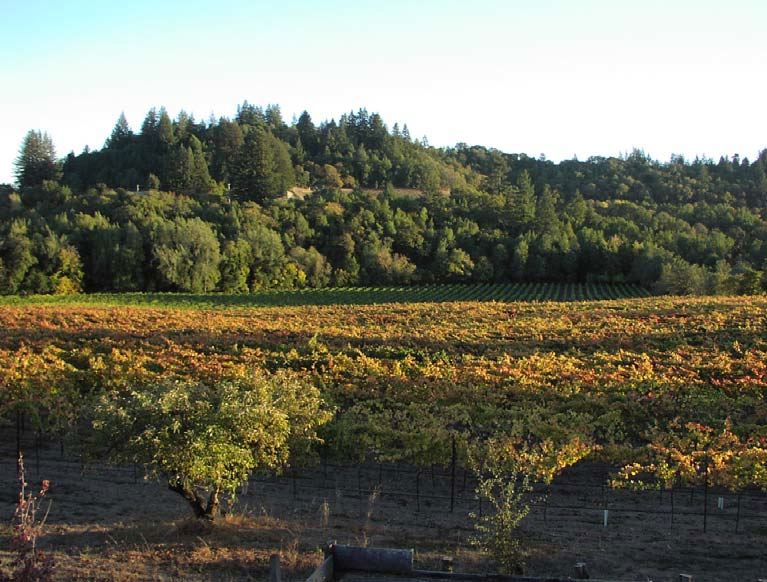 Marcy Keefer, a former nurse, and her spouse, Robert Keefer, MD, now deceased, purchased the former apple orchard property in 1985. The original plantings date to 1988. The vineyard is now farmed by Marcy and her son Craig Strehlow. The clonal mix is diverse including Dijon 114, 115, 777, Pommard 5, Mariafeld (23), Wädenswil (2A), and Swan and Calera selections. In 2010, phased replanting of the estate Chardonnay was completed and 2 acres of Calera selection and 3 acres of Swan selection, both of which perform well on this site, were planted. Some of the newer Pinot Noir plantings will eventually go into the Keefer Ranch Estate Pinot Noir. For many years, Keefer Ranch has supplied grapes to notable Pinot Noir specialists including most recently, A.P. Vin, Failla, Freeman, Kosta Browne, Loring Wine Co., Pali Wine Co. and Siduri. Beginning in 2006, the Keefer Ranch label was launched. The first two vintages included Swan and Pommard 5 clones and beginning in 2008, Dijon 115 was added to the blend. Craig handles the winemaking duties, crafting an exemplary estate Pinot Noir that offers a charming, delicate style that has bright acidity. The Keefer Ranch Vineyard is truly a Russian River Valley treasure. Keefer Ranch Pinot Noir is sold through a mailing list at www.keeferranch.com.
2008 Keefer Ranch Green Valley of Russian River Valley Estate Pinot Noir 14.2% alc., 241 cases, $42. Released June 20, 2010. Swan, Pommard 5 and Dijon clone 115. 20% whole cluster fermentation. Aged 12 months in 40% new French oak. · The nose blossoms over time offering lovely scents of black cherries, nutmeg, cut flowers, and underbrush. A little darker and more intense than the 2007 offering, but remains a feminine style with pleasing delicate dark red cherry fruit, gossamer tannins, an alluring silkiness, with an intense cherry flavored finish. Beautifully balanced. Not offering all it is capable of now, this wine deserves further cellaring for at least a year. Very Good.
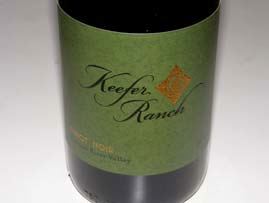 2007 Keefer Ranch Green Valley of Russian River Valley Estate Pinot Noir 14.2% alc., pH 3.42, 243 cases, $42. Swan and Pommard 5 clones. 20% whole cluster fermentation. Aged 12 months in 25% new French oak barrels. · Bright Bing cherry aromas with a complimentary accent of spices including nutmeg leading to crisp and satisfying flavors of black cherries, strawberries, and raspberries with hints of spice box, cola and green tea that fan out nicely on the pleasing finish. A seamless wine with silky tannins and no discernible oak. A treasure of a wine that really delivers the goods.
Kelley Fox WinesCarlton, Willamette Valley, OregonWinemaker Kelley Fox has been crafting wines in Oregon for over ten years including terms at Hamacher, The Eyrie Vineyards and Torii Mor. Since 2005, she has been the co-winemaker with Scott Wright at Scott Paul Wines in Carlton, where she emulates the elegant style of Pinot Noir that her mentor at The Eyrie Vineyards, David Lett, taught her. She says, “What I love most about Pinot is its transparency. I prefer authenticity and even grit to armchair idealism. Pinot does this. There is something so real about it, for the better or the worse.” Beginning with the 2007 vintage, she partnered with her father, Gerson Stearns, and launched her eponymous label, Kelley Fox Wines. The tiny production (about 200 cases) from Momtazi and Maresh vineyards has caused quite a buzz among Pinot Noir aficionados in Oregon. Her wines are, in her words, “Genuine, truth telling, and pleasure-giving.” Fox’s wines tend to be modest in alcohol with restrained use of new oak. The 2008 vintage wines are a touch more structured and fruity, less approachable now, and probably more age worthy than their 2007 counterparts which were previously reviewed by me with gusto (www.princeofpinot.com/winery/1033/). Kelley Fox Pinot Noirs may be obtained through the website at www.kelleyfoxwines.com or from retailer Michael Alberty, who considers Kelley Fox one of his favorite Willamette Valley winemakers, at www.StorytellerWine.com in Portland.
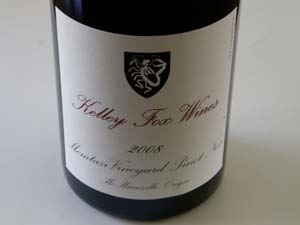 2008 Kelley Fox Momtazi Vineyard McMinnville Willamette Valley Pinot Noir 13.5% alc., $39, screw cap. Sourced from an 11-year-old block of 113 and 115 clones. Aged in 30% new French oak. · Scents of green olive, mulberry and pharmaceutical blow off over time to reveal subtle well-oaked fresh berry aromas with a hint of pine pitch. The wine really pumps out a panoply of berry flavors with a well-married oak component. Soft and demure, the wine is much better integrated with more pure fruit aromas and flavors the next day from a previously opened and re-corked bottle. Should blossom in a few years. Good.
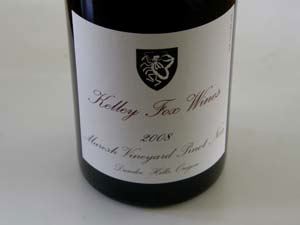 2008 Kelley Fox Maresh Vineyard Dundee Hills Willamette Valley Pinot Noir 13.0% alc., $49, screw cap. From over 38-year-old non-irrigated Wädenswil vines. Aged in 30% new French oak. · Enticing and effusive aromas of spiced cherries, woodshed and evergreen. Very charming cherry, red currant and red plum fruit with hints of cola and brown spice. A loamy note adds character. Silky smooth with soft tannins and impeccable balance. Still a debutante and best to keep your hands off this one for a couple of years. Very Good.
Kokomo WineryRussian River Valley, Sonoma County, CaliforniaI was first exposed to a marvelous Pinot Noir fashioned by Eric Miller of Kokomo Winery at a Newcomers Focus Tasting offered at the 2009 Pinot Days in San Francisco (2006 Kokomo Wines Peters Vineyard Sonoma Coast). This was one of the better Pinot Noirs in the seminar which offered many bright new stars in the Pinot game. Miller, a native of Kokomo, Indiana, studied at University of California at Davis and apprenticed at both Belvedere Winery and Amphora Winery. Along with his best friend and college roommate, Josh Bartels, and partner Randy Peters, a well-known winegrower, he launched Kokomo Winery in 2004 at Timber Crest Farms in Dry Creek Valley, Healdsburg. The Tiber Crest Estate is also home to Amphora Winery, Papapietro Perry Winery, Peterson Winery and Family Wineries Tasting Room. Photo L to R, Randy Peters, Eric Miller, Josh Bartels.
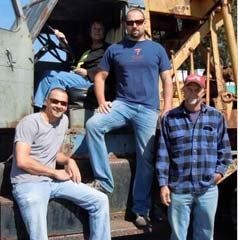 The Kokoma label logo sports a coastal Cypress tree, signifying Miller’s move to the West Coast from Indiana. The focus is on Dry Creek Valley, Russian River Valley and Sonoma Coast fruit and single-vineyard bottlings. Multiple varietal wines are produced including whites (Chardonnay, Sauvignon Blanc) and reds (Cabernet Sauvignon, Petite Sirah, Pinot Noir, Merlot, Sangiovese and Syrah). Two Pinot Noirs are offered from Peters Vineyard in the Sonoma Coast AVA, and Windsor Oaks Vineyard in the Russian River Valley AVA. Kokomo wines are sold online at www.kokomowines.com. The winery’s tasting room is incorporated into the winery cellar and is open daily from 11-4:30 at 4791 Dry Creek Road in Healdsburg. The phone is 707-433-0200.
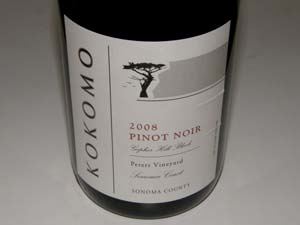 2008 Kokomo Peters Vineyard Gopher Hill Block, Sonoma Coast Pinot Noir 14.1% alc., 160 cases, $38. Peters Vineyard was planted on Goldridge sandy loam soil in the early 1980s by Randy Peters. This wine is sourced from a block planted to Wädenswil clone. Aged in 30% new French oak barrels. · Moderately light reddish-purple hue in the glass. Oak-kissed red fruit aromas initially, developing more fruit intensity over time in the glass revealing scents of cherry cobbler. A medium-weighted offering featuring a complex array of flavors including tasty red cherries and berries, Red Vines, earth, tea and leaf. Silky smooth with plenty of charm and delicacy. Good.
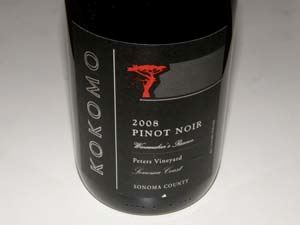 2008 Kokomo Peters Vineyard Winemaker’s Reserve Sonoma Coast Pinot Noir 14.1% alc., 485 cases, $48. This wine is sourced from a block planted to Pommard clone. 25% whole cluster. Aged in 100% French oak barrels. · Moderately light reddish-purple color in the glass. Toasty oak and spice-infused black cherry aromas really draw you in. A panoply of dark red Pinot fruits coat the mouth with subtle oak, spice and tar singing in the background. Without knowing this wine had whole cluster when I tasted, I picked up immediately on the spice and soft mouth feel that is characteristic of this mode of fermentation. For me, whole cluster, if done right, adds a whole other dimension to a wine. In addition, this wine has silky, soft tannins and complimentary acidity bringing you back for another sip.
LittoraiSonoma Coast, CaliforniaYou are probably tired of reading about my hosannas to Ted Lemon, but I just can’t say enough good things about this remarkably talented California winemaker. Along with his wife, Heidi, he founded Littorai in 1993 after spending a summer driving up and down the Pacific Coast tasting local wines and learning about the soils and history of the local vineyards. Lemon had a firm belief in terroir, inspired by his years of studying and making wine in France. According to Lemon, “I believe soil is of major importance in a wine’s character. It’s clear there are tremendous differences between wines made from vineyards right next to each other even if they are vinified and treated exactly the same way.” The Lemons settled on sourcing grapes from vineyards in western Sonoma and western Mendocino counties. He was convinced that the finest Pinot Noir and Chardonnay were grown along the true coastal zone of the continent. The couple named their new venture Littorai, a pleural noun formed from the Latin word litor-, which means the coasts. Lemon carefully supervises all vineyard sources and believes strongly in sustainability and biodynamie. His vineyard sources are household names to pinotphiles and include Summa, B.A. Thieriot, Hirsch, Pratt, One Acre, Savoy, and Cerise. Estate vineyards including The Haven and Pivot have been added to the mix in recent years. Littorai Pinot Noirs and Chardonnays are among the most age worthy wines made in California, a reflection of impeccable winemaking and stellar balance of the finished wines. Consistency is also a feature. I have tasted practically every wine Lemon has crafted, and some were certainly more outstanding than others, but a thread of excellence was evident in the winemaker’s craft with each wine. I often get asked, “Who is your favorite Pinot Noir producer?” The question is impossible to answer, but Littorai is always among the names that come into consideration. Littorai wines are sold exclusively through a mailing list with widespread distribution to fine restaurants throughout the United States. Littorai wines are a favorite of sommeliers. The winery website is www.littorai.com. Until recently, magnum formats were only offered after years of aging, but with the 2008 vintage, magnums have been made available upon release of the vintage. Some Littorai wines may be available, including older vintages, by contacting Littorai directly at 707-823-9586, A 10,000 square-foot winery was completed on the Lemon’s property located between Sebastopol and Freestone in western Sonoma County. Tours and tastings are offered by appointment. The winemaking facility is impressive and innovative, constructed of straw bales and using gravity flow for production. The winery property is farmed as a self sustaining, integrated and diversified farm and offers a unique opportunity to tour a biodynamic farm and vineyard. Lemon is very high on the 2008 wines and as you can see from my reviews below, so am I. Very impressive, polished wines, all with alcohols under 14.0% (a reflection of the effort expended in farming that allows for phenolic ripeness at moderate brix), and the balance to carry them for years and years. Lemon sets the bar very high for California Pinot Noir.
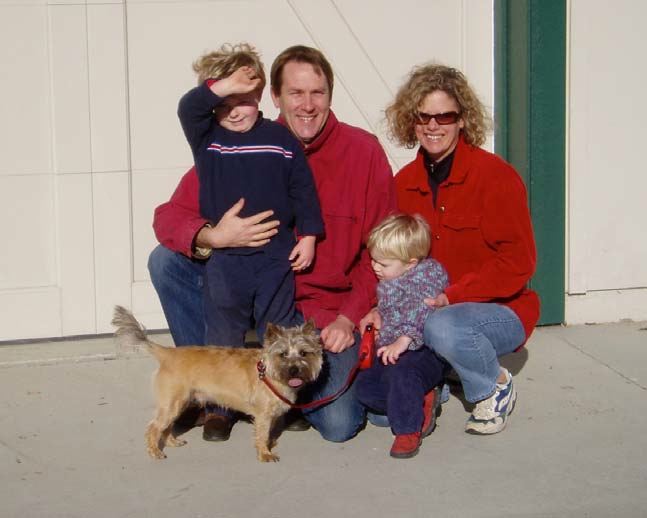
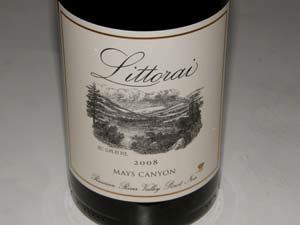 2008 Littorai Mays Canyon Russian River Valley Pinot Noir 13.8% alc., $65. · Moderately dark reddish-purple robe. Very expressive forward nose that is constantly changing in the glass offering scents of spiced Bing cherries, alpine strawberries, cola, mocha and toast. Crisp and delicious on the palate featuring darker red cherries and berries with just the right amount of oak and spice in the background. A cherry delight on the bright finish. A kick-ass Pinot that displays the typically luscious Russian River fruit beautifully. Can drink it now, but will further reward patience. Flat-out great the next day from a previously opened and re-corked bottle.
2008 Littorai The Pivot Vineyard Sonoma Coast Pinot Noir 13.9% alc., $60. From young vines planted on the Littorai Estate property. · Moderate reddish-purple color in the glass. The alluring aromas black cherries and raspberries with a hint of toasty oak sends a welcoming message. Light in intensity but pleasing with flavors of cherries, red berries and oak-derived coffee. Demure and very approachable now, with silky tannins and a good grip of acidity that frames the fruit and lifts the crisp finish. I would drink this early on. Good.
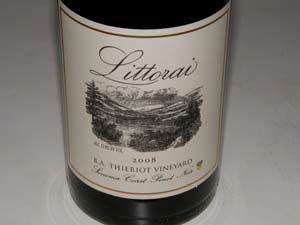 2008 Littorai B.A. Thieriot Vineyard Sonoma Coast Pinot Noir 13.9% alc., $70. · Moderately dark in color and in intensity. Very sexy perfume of rose petals and fresh Pinot fruit basket. Would love to bottle this aroma. I always find this wine seductive and this vintage is no exception. That is not to say that it is ready to drink, for it is still somewhat ponderous, the delicious core of purple berries and plums only teasingly apparent at present. Thick with fruit wrapped in velvety tannins, this beauty wows you now but will be more amazing in a few years. This wine is why Pinot is my paramour.
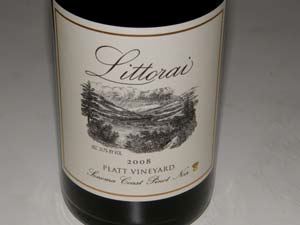 2008 Littorai Platt Vineyard Sonoma Coast Pinot Noir 13.7% alc., $60. · Very shy and demure perfume of raspberry tart, vanilla and baking spices elevating over time in the glass. A curvy, saucy wine that is somewhat forward offering a lovely array of black cherry and berry fruits with subtle spice and citrus in the background. Seamless, with a good core of ripe tannins and balancing acidity that give the wine a caressing sensation in the mouth. The best comes last, as the generous fruits cascade on the amazingly persistent finish. Pick any superlative you want. My choice would be “heavenly.”
LongoriaSta. Rita Hills, CaliforniaI can remember way back in the early 1980s when I was becoming captivated by Pinot Noir, Longoria was one of the labels I sought out as one of the few at the time to show the promise of California Pinot Noir that eventually was to be fulfilled. Rick Longoria is now a veteran winemaker who first appeared in Santa Barbara County in 1976 after spending two years at Buena Vista Winery where he developed a close friendship with Andre Tchelistcheff. His first head winemaking job was at J. Carey Cellars which did not offer Pinot Noir and Chardonnay. Longoria sensed that those two varieties were poised to become the signature varietals for the Santa Barbara County wine region, leading him to seek an outlet for his expectations. The eponymous Longoria label was established in 1982 by Rick and his wife Diana, releasing 500 cases of Chardonnay and Pinot Noir from Santa Maria Valley vineyards. Longoria became the winemaker at Gainey Vineyard in 1985 and in 1997, gave up his job to devote his full energies to his own label, moving his winery operation to the Lompoc “Wine Ghetto.” This warehouse winery locale is well known now, but Longoria was the first to make wine in this Lompoc location. Although Longoria crafts 3,500 cases of several varietals from his winery in Lompoc, his featured wine is the Pinot Noir sourced from his 9.75-acre estate Fe Ciega Vineyard located in the southwestern portion of the Sta. Rita Hills appellation. The name, Fe Ciega, translates to “blind faith,” and it was blind faith that led him to plant this vineyard originally in 1997 to Pommard and Dijon clones 115 and 667. Small amounts of Pinot Noir and Chardonnay acreage were added in 2008. The vineyard is situated on a small mesa in the middle of a 40-acre ranch owned by Hank and Brenda Klehn. Located at the western end of the Sta. Rita Hills viticultural appellation, the vineyard’s cool climate, clay loam soil with shale fragments, and gentle southern exposure combine to produce memorable Pinot Noirs. Longoria buys Pinot Noir grapes from a number of other sources including Rancho Santa Rosa Vineyard, Bien Nacido Vineyard and Sanford & Benedict Vineyard, and crafts vineyard-designated wines from these sites. The Fe Ciega Vineyard bottling, however, remains his signature wine. Longoria wines are sold online at www.longoriawine.com. The tasting room at 2935 Grand Ave., in Los Olivos is open daily. Older library wines are offered on the website.
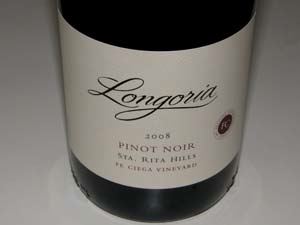 2008 Longoria Fe Ciega Vineyard Sta. Rita Hills Pinot Noir 14.2% alc., pH 3.61, 616 cases, $48. Pommard, Dijon 115 and 667. Aged 11 months in 28% new French oak barrels. · Moderate reddish purple color in the glass. A savory wine with aromas of berry jam, deeply colored red roses, underbrush, herbs and toasty oak. Plenty of black raspberry and black cherry fruit is front and center with accents of oak and grilled meat. Supple in the mouth with fine grain tannins enrobing the hi-tone fruit that persists with a vengeance on the great finish. Even better the next day from a previously opened and re-corked bottle with better integration of oak-derived flavors and aromas. This is a wine of character and interest that sings its own tune. Further cellaring should enhance its pleasure.
Luminous Hills WineryYamhill-Carlton District, Willamette Valley, OregonLuminous Hills Vineyard is located in the southwestern corner of the Yamhill-Carlton District. The vineyard is a unique high elevation site with both sedimentary and Jory volcanic soils. The planted clones have been carefully matched to the different soil types, creating six different blocks containing Dijon clones 115, 667, 777 and Pommard clone.
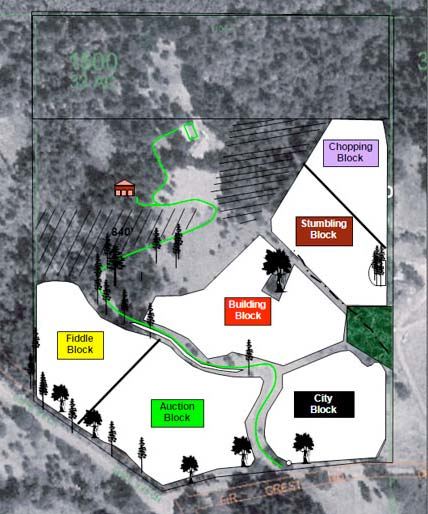 The vineyard is dry farmed with irrigation available as a safety net for difficult vintages. Farmed sustainably, Luminous Hills Vineyard is part of the Low Input Viticulture & Enology (LIVE) program. Two wines are produced from this site: a Luminous Hills Vineyard Pinot Noir and a LUX Pinot Noir representing a special selection of barrels representing a combination of Pommard clone planted on sedimentary soil and Dijon 777 clone planted on Jory volcanic soil. The inaugural vintage from this vineyard was 2008. Luminous Hills wines are poured at the Seven of Hearts Wine center at 217 West Main Street in Carlton. The Luminous Hills Winery companion label, Seven of Hearts Wine, features wines sourced from several appellations within the Willamette Valley and neighboring regions. Both labels are the work of Byron Dooley and his wife Dana, escapees from Silicon Valley, who sold their house then the internet bubble burst in 2000 and moved to Napa’s Howell Mountain. Dooley earned his viticulture and winemaking degree at Napa Valley College, interned at Williams Selyem and made his own Bordeaux-style wine from Napa fruit. In 2004, after Dooley graduated from college, the couple located a property in the Yamhill-Carlton District and developed a 12-acre vineyard planted to Pinot Noir named Luminous Hills. Dana opened Honest Chocolates in McMinnville, selling traditional-style chocolates and later another branch in Carlton which shares space with the Seven of Hearts tasting room. Seven of Hearts wines (www.sevenofheartswine) and Luminous Hills (www.luminoushills.com) wines are sold on the respective websites.
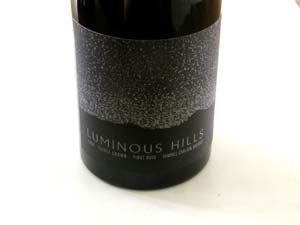 2008 Luminous Hills Yamhill-Carlton District Estate Grown Pinot Noir 13.2% alc., 142 cases, $30. · Plenty of oak character in the nose augmenting the cherry and rose petal aromas. Tasty essence of raspberry coulis with some oak-derived mocha and cherry Life Saver flavor. Soft in the mouth with the fruit displaying a persistent grip and brightness from lively acidity. Good.
Valerie’s VineyardCarneros, Sonoma County, CaliforniaForget small, we are talking tiny here. Only 70 cases were produced from the 1-acre Valerie’s Vineyard in 2008. This vineyard is a group managed affair, the result of a partnership between long time Sonoma County public relations person Michael Coats, his wife Valerie, her parents and sister, and Chuck Hanson, a wine buyer for Hi-Time Wine Cellars in Costa Mesa, California for 53 years, and Jerry Hanson. Each of the partners share equally in the work of the vineyard which is organically farmed and overseen by viticulturist Phil Cotourri.
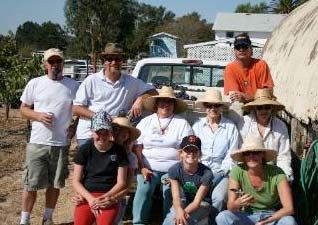 The vineyard, formerly the site of a plum orchard, was originally planted in 2000 by vineyardist Chuy Ordaz on resistant rootstock and a secret Russian River Valley sourced clone. The land sits less than 500 feet from the appellation line dividing Sonoma Valley and Sonoma Carneros. Yields are just under 2 tons per acre. The Valerie’s Vineyard Pinot Noir is crafted by B.R. Cohn Winery winemaker, Tom Montgomery, at B.R. Cohn Winery in Glen Ellen. Both of the previous two vintages of Valerie’s Vineyard Pinot Noir were stellar and were reviewed previously (www.princeofpinot.com/winery/811/). Valerie’s Vineyard Pinot Noir may be acquired by e-mailing michael@coatspr.com or visiting the Hit-Time Cellars website at www.hitimewine.net. There is limited Sonoma Valley restaurant and retail distribution. The Valerie’s Vineyard website is www.valeriesvineyard.com.
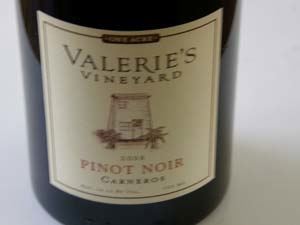 2008 Valerie’s Vineyard Carneros Pinot Noir 14.1% alc., $40. Aged 18 months in new and two-year-old French oak barrels. · Ornate aromas and flavors of dark berries, Mu Shu plum sauce, cassis, tea, brown spice, and loamy earth. Very smoothly textured with finely ground tannins and amazing persistence of perfectly ripe fruit on the finish. The wine really grows on you over time. Will benefit from 1 to 2 more years in bottle. Year in and year out, one of the best Pinot Noirs to come out of Carneros.
White Rose Estate WinesDundee Hills, Willamette Valley, OregonSouthern California businessperson, Greg Sanders, acquired the well-established 10-acre White Rose Vineyard in the Dundee Hills in 2001. The self-rooted vineyard, originally planted to Pommard clone in 1980, is well-positioned with several prominent producers nearby including Archery Summit, Domaine Serene, Domaine Drouhin Oregon, DePonte Cellars, and the original vineyard planting of David Lett. Prior to Sander’s acquisition, White Rose Vineyard had become famous for the quality of its fruit and supplied notable Pinot Noir specialists such as St. Innocent, Panther Creek and Torii Mor, all of which bottled White Rose Vineyard designated wines. St. Innocent continues to be a yearly recipient of White Rose Vineyard fruit. White Rose Vineyard is planted on east-southeast facing slopes of volcanic Jory soil at 870 feet elevation. In 2009, an additional 4 acres of vineyard immediately north of the original site was acquired. This vineyard was planted in 2001 to Dijon clone 115. Some fruit for White Rose Wines is also purchased from top growers in adjacent appellations. Sanders devoted considerable time and money in upgrading the vineyard and building a small winery with a tasting room directly above it overlooking Mt. Hood and the Willamette Valley. Sanders is a Burgundian devotee who uses some of Burgundy’s top Grand Cru wines as his model in crafting his wines. He learned his winemaking through University of California at Davis courses and extensive tasting, and started producing wine in 2001. After seven vintages as the winemaker, Sanders appointed long time White Rose Vineyard Manager, Jesus Guillen, also self-taught, as winemaker in 2007. The 2008 growing season at White Rose Vineyard was very favorable, allowing fruit to be picked only when flavors were optimal. Yields were 1.5 to 2 tons per acre and Sanders noted that the fruit could be the best ever from this vineyard. I have to hand it to Sanders. When he bought the White Rose Vineyard, he knew little about viticulture and winemaking, and was something of an outsider in this region with some very well-financed wineries. He has had a number of challenges along the way, but he has persevered, and today his Pinot Noirs are among the best that Oregon has to offer. When Jay Miller of the Wine Advocate visited White Rose this year, he gave high scores to several White Rose Estate wines and placed two of them among the top five Oregon Pinot Noirs from the 2008 vintage. Sanders’ dreams of Grand Cru quality wines from Oregon have been realized.
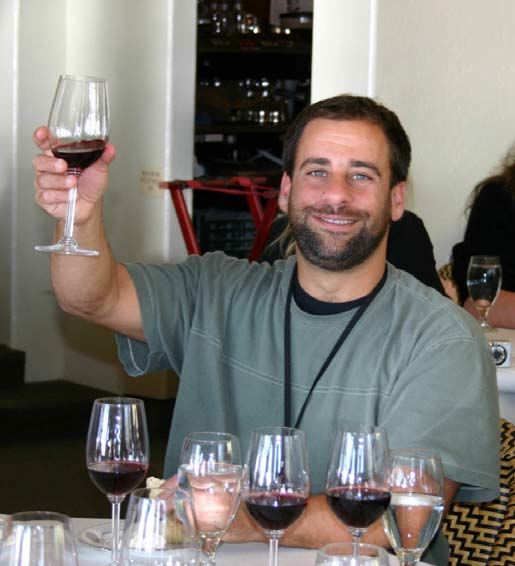 Recently, Sanders undertook a modernization of the winery’s website and a significant redesign of the winery’s label and logo. The package now is more flattering and more reflective of the excellence offered inside the bottle. The only holdover of the previous winery label and wine naming is the 2008 Dragon’s Bluff Pinot Noir reviewed below.
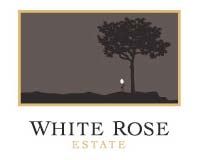 The 2008 lineup of Pinot Noirs includes the White Rose Estate Willamette Valley Pinot Noir ($30), the 2008 White Rose Estate Dundee Hills Pinot Noir ($45), the 2008 White Rose Estate Whole Cluster White Rose Vineyard Pinot Noir ($75), the 2008 White Rose Estate Sovarae White Rose Vineyard Pinot Noir ($75), and the 2008 White Rose Estate White Rose Vineyard Pinot Noir ($75). The wines are sold online and through a mailing list at www.whiterosewines.com. The tasting room at 6250 NE Hilltop Lane in Dayton is open 11-5 weekends and Monday through Friday by appointment. The phone is 503-864-2328.
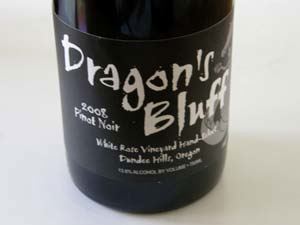 2008 Dragon’s Bluff White Rose Vineyard Hand-Select Dundee Hills Willamette Valley Pinot Noir 13.8% alc., $75. 50% whole cluster. · Moderate reddish-purple color in the glass. A bit funky upon opening, improving with swirling to reveal aromas of black raspberries, candied apple, oak toast and vanillin. Discreetly rich flavors of dark red raspberries and Red Vines with an underpinning of vanilla oak and spice. The zingy acidity brightens the fruit and the soft, dusty tannins allow for easy drinking. The wine finishes with a lingering grip of generous fruit. Good.
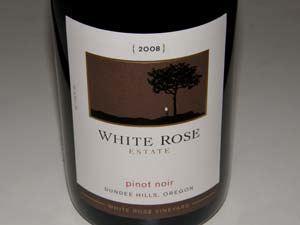 2008 White Rose Estate White Rose Vineyard Dundee Hills Willamette Valley Pinot Noir 13.9% alc., pH 3.45, 176 cases, $75. The winery’s flagship wine. Fruit from blocks 2, 3 and 5 was 80% de-stemmed with 20% whole cluster, and fruit from block 1 was 100% whole cluster fermented. 20 to 26 days of skin contact, pressed off with a wooden basket press. Aged 14 months in 13% new French oak barrels. · Moderately deep ruby color in the glass. Shy, but haunting aromas of black cherries, grilled meat and spice. A black tie, sophisticated wine that is still a bit stiff and formal and needs time to unwind. That said, it offers a perfect balance of perfecgtly ripe cherry and berry fruit, vital acidity and refined tannins. The silky mouth feel adds to the allure. The beauty of this wine grows on you over time in the glass and is spectacular the next day from a previously opened and re-corked bottle. Very classy juice.
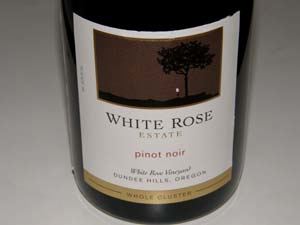 2008 White Rose Estate Whole Cluster White Rose Vineyard Dundee Hills Willamette Valley Pinot Noir 13.8% alc., pH 3.51, 98 cases, $75. 100% whole cluster fermentation. 15 day post-fermentation maceration yielding a total of 26 days of skin contact. Pressed off in a wooden basket press and barreled down in neutral French oak for 14 months. Racked once after MLF and again just before blending. · Gorgeous perfume of cherries flush with baking spices including cinnamon, with added notes of rose petals and sandalwood. Happy to just smell this wine. Stylish and expressive, the luscious fruit is alive with charm accented by exotic spices and edible flower with plenty of firm tannin to balance the fruit. Never fades in the glass, pumping out lively aromas and flavors until the glass is emptied. I am a sucker for whole cluster done right and this wine really delivers.
Windy Oaks Estate Vineyards & WinerySanta Cruz Mountains, CaliforniaJim Schultze is the type of winemaker you come upon occasionally who strikes you as very accomplished. Blessed with a charming calmness and trustworthy demeanor and armed with a meticulous and well-thought out approach to winemaking, Schultze gives you the feeling that his grapes are in good hands.
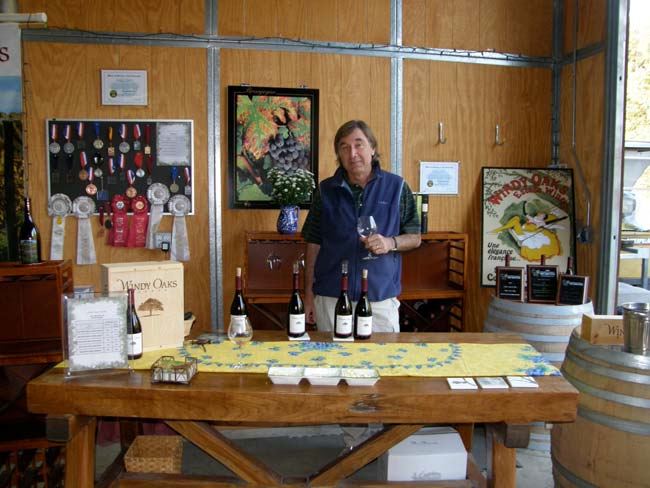 Jim and Judy Schultze escaped from the corporate world and have used their twenty years of interest and experience in artisan winemaking and winegrowing to create Windy Oaks Estate. They produce Pinot Noir and Chardonnay from a 15-acre vineyard located at 1,000 feet on a ridge overlooking the town of Corralitos at the southern tip of the Santa Cruz Mountain range. Viticulture and winemaking at Windy Oaks Estate is very Burgundy-themed. The vineyard is farmed according to sustainable, organic principles with every vine hand-tended and directly monitored for water status. The vineyard sits above the fog line and enjoys modestly warm summers without heat spikes. Temperatures are consistently in the 70s dropping into the 40s at night. The site is suited for Pinot Noir and yields physiologically ripe grapes without high brix and with high natural acidity. The growing season is extraordinarily long, often extending into late October or even November.
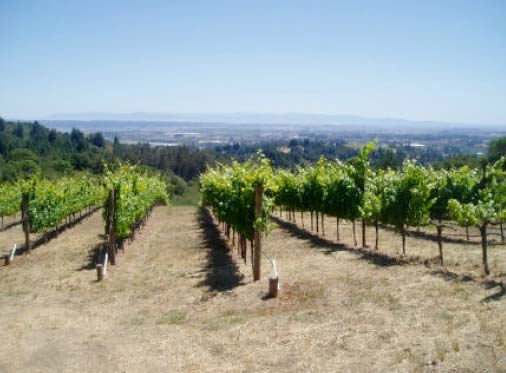 The planted Pinot Noir clones are Dijon 115, 667, 777 and 828, and 2A and Pommard. Chardonnay was planted upon the insistence of Judy Schultze, and the 1-acre of Chardonnay provides a lovely compliment to the range of Pinot Noirs. Winemaking is non-interventional with no additives. Schultze crafts a variety of styles of Pinot Noir including wild yeast, whole cluster and wood tank fermented wines. A special Burgundian clone Pinot Noir is particularly noteworthy, made from a half-acre portion of the vineyard that Jim Schultze hand tends to personally and is planted to a undisclosed clone from Burgundy that is rarely planted here. The Schultzes travel to Burgundy yearly to meet with coopers. They use 3-year-old air dried and tight grain French oak barrels and age their Pinot Noirs for 18 to 25 months with a relatively high percentage of new oak (50% to 75%). The small and modest winery on the estate property (see page 1 of this issue) is outfitted with all the latest winemaking technology and is gravity-driven. A state-of-the-art bottling line is employed allowing for minimal oxygen uptake that protects wines from bottling shock. Windy Oaks Estate sells 85% of their wine directly to a mailing list at www.windyoaksestate.com. Wine club members receive significant discounts. Nine different Pinot Noirs are currently offered. Tasting is available periodically through special winery and appellation events, major Pinot Noir festivals and by appointment. The phone is 831-786-9463. One of the Schultze’s sons is an aspiring winemaker who is becoming involved in the business. Judy Schultze handles the marketing and business side of the winery. Windy Oaks Estate has just released three wines from the 2008 vintage: Estate Pinot Noir Henry’s Block, 100% Whole Cluster, and Wild Yeast. The 2006 Special Burgundian Clone Estate Pinot Noir, the third vintage from this special half-acre block, is also being released at this time ($95). Some of the wines below have been previously reviewed but I thought it would be of interest to check in on them again. Because the Schultzes are meticulous in their selection of French oak barrels, the wines are never oaky although the wines are raised in a high percentage of new oak.
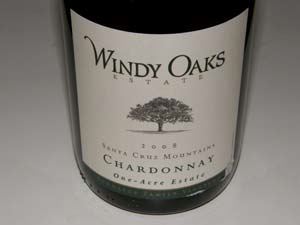 2008 Windy Oaks Estate One Acre Santa Cruz Mountains Chardonnay 13.9% alc., 131 cases, $38 (Sold out). Aged 15 months in 33% new French oak. Unfined and unfiltered. · Light straw color in the glass. Interesting aromas of apple, brioche, oregano and savory spices with subtle oak. Good richness of flavor offering citrus, Asian pear, vanilla, banana, and oak-derived toffee in the background. An exotic tasting Chardonnay that avoids the mainstream trap and I applaud the wine for its uniqueness. Good.
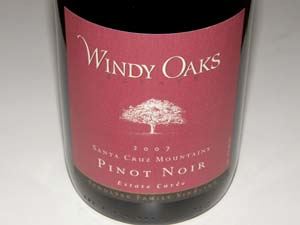 2007 Windy Oaks Estate Cuvée Schultze Family Vineyard Santa Cruz Mountains Pinot Noir 13.9% alc., 360 cases, $38 (sold out but the 2008 vintage has been released). A blend of all clones from the estate vineyard. Aged 16 months in 55% new French oak. Unfined, unfiltered. · Moderately light reddish-purple color in the glass. Very attractive perfume of spiced and confected cherries, cherry cola and red berries. The flavors echo the aromas and are offered in a lightly weighted style with soft, silky tannins. A very solid easy drinker. Very good.
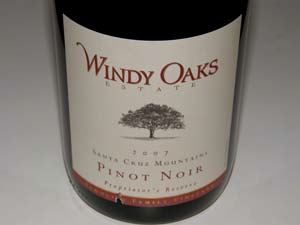 2007 Windy Oaks Proprietor’s Reserve Schultze Family Vineyard Santa Cruz Mountains Pinot Noir 14.1% alc., 384 cases, $60. Primarily sourced from the 1.5-acre Bay Block, part of the original 3-acre vineyard. Aged 23 months in 75% new French oak barrels. · Interesting disconnect between the reserved earthy nose and the flavorful fruit core. Shy scents of damp earth, decay, mushroom and oak. Intense flavors of dark red stone fruits and berries with hints of lovely spice, cherry cola and oak. Picks up power and interest over time in the glass offering a persistent tug of tasty strawberry fruit on the finish. Similar to the Estate Cuvée in taste, but ramped up another notch. Very Good
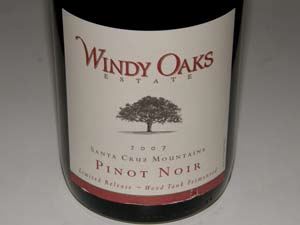 14.2% alc., $55. Fermented in one-ton French oak open fermentation tanks. Aged 21 months in 75% new French oak barrels. Unfined and unfiltered. · Light garnet in color in the glass. A striking aromatic profile of cherries, berry pie, sandalwood, spice and a touch of caramel. Charmingly delicate but pleasingly flavored core of redder cherries and berries. Sleek and refined with mild tannins and no oak intrusion, this is a lullaby.
2007 Windy Oaks Limited Release Wild Yeast Schultze Family Vineyard Santa Cruz Mountains Pinot Noir 14.3% alc., 133 cases, $55. A five barrel selection. Aged 17 months in 65% new French oak barrels. Unfined and unfiltered. · Moderate reddish-purple color in the glass. Very reserved scent of black cherries and dark red berries with a hint of mint. Pretty tasty black cherry and berry fruit, nicely spiced and earthy, clothed in ripe firm tannins, and harmoniously composed. A solid drink, but doesn’t excite. Good.
2006 Windy Oaks Proprietor’s Reserve Schultze Family Vineyard Santa Cruz Mountains Pinot Noir 14.1% alc., 345 cases, $60. Primarily sourced from a 1.5-acre block planted as part of the original 3-acre vineyard. Aged 22 months in 80% new French oak barrels. Unfined and unfiltered. · Bright and intensely perfumed berry and cherry fruit on the nose. Mouth filling core of ripe berry fruit with notes of dried cherry, cassis and spice. A refreshing acid tang frames the aromatic finish. Very Good.
2005 Windy Oaks Proprietor’s Reserve Schultze Family Vineyard Santa Cruz Mountains Pinot Noir 14.3% alc., $60. Unfined and unfiltered. · Intense aromas of deep, dark fruit with whiffs of savory herbs, cut flowers and oak. Tasty core of cherry and berry melange that is on the verge of fading, taking on some secondary characters of brown spice, mocha and raisin. Riper and lighter in weight than the 06 and 07 bottlings but with a similar prominent acid underpinning. Drink up soon. Good.
2005 Windy Oaks Special Burgundy Clone Schultze Family Vineyard Santa Cruz Mountains Pinot Noir 14.3% alc., $95. Unfined and unfiltered. · Shapely bottle with long cork and attractive embossed label. Moderate burnished red rose color in the glass. Fresh aromas of mixed berries, chocolate truffle, spice, flower garden and a hint of oak. Delicious strawberry and black cherry core nicely spiced with a subtle kick of acidity on the amazing finish that seems to persist for a minute. The layers of flavor seem to defy proper description. Very soft and plush on the palate. A very unique wine that is in a class of its own.
Drinking BiggerUsing the term “big” when referring to Pinot Noir wineries is relative. The so-called big Pinot Noir wineries are still very small compared to some of the giants in the wine industry such as E. & J. Gallo and Bronco Wine Company. The larger Pinot Noir producers vinify Pinot Noir in the same fashion as the boutique wineries, but do it on a larger scale, say with 60 large fermenting vessels versus 12 small ones, with access to more vineyard sources (many of which are estate owned), and more man power. Often a value-priced line of wines are produced in large quantities to compliment the small lot vineyard-designated Pinot Noirs. Total annual production is often well over 5,000 cases, but the quality standards are high, and as in the case of the wineries included below, the wines can equal or surpass those crafted by their small artisan brethren.
Freestone VineyardsSonoma Coast, CaliforniaIn 1999, Joseph Phelps (known for Napa Valley Insignia), his son Bill, and the Joseph Phelps Vineyards management team purchased a former dairy farm of 89 acres in Freestone, a hamlet in the true Sonoma Coast. The site was well suited to Chardonnay and Pinot Noir. Planting began the next year with staged replanting continuing until 2007. Freestone Vineyard Estate consists of three distinct properties. The Pastorale Vineyard is planted to 34 acres of Pinot Noir and nearly 22 acres of Chardonnay at the end of Freestone Flat Road adjacent the new Freestone winery facility. The acquisition of additional property led to nearby Quarter Moon Vineyard (41 acres of Pinot Noir) and a long-term lease was established for the fruit from nearby Ferguson Vineyard (6 acres of Pinot Noir). Growing and ripening wine grapes in this very cool area has been a challenge from the beginning. Yields can be very low due to poor berry set in the cool days of the spring growing season. It is not unusual to have 45 degree temperature swings in a single day here. There has been a huge financial commitment required to succeed here. The 40,000 square foot winery, completed in time for the 2007 harvest, is built into the hillside and employs gravity-flow by its three level construction. The winery is not open to the public due to local environmental concerns, but I have visited and found it to be impressive in every way. The Director of Winemaking is Phelps veteran Damien Parker. The Winemaker is Theresa Heredia who is assisted by Justin Ennis and consulting Burgundian Pascal Marchand. The first vintage of Pinot Noir produced from Sonoma Coast grapes was released as the 2004 Fogdog Pinot Noir from purchased grapes. Fog dog refers to a bright or clear spot appearing in a breaking fog and the name has been retained for the solid, early drinking and larger production Pinot Noir and Chardonnay wines. In 2005, 600 cases of Freestone Vineyard Sonoma Coast Pinot Noir were produced and by 2006, 2,700 cases. Beginning with the 2007 vintage, full production ensued, with premium Chardonnays under the Ovation, Freestone Vineyards Sonoma Coast and Freestone Vineyards Pastorale Vineyard labels, and premium Pinot Noirs that include Freestone Vineyards Sonoma Coast and vineyard designates from Quarter Moon Vineyard and Pastorale Vineyard. The 2008 Freestone wines were unaffected by the smoke from fires, possibly because the Freestone vineyards sit in a fog layer. The Freestone Vineyards Guest Center is open for tasting Thursday through Monday from 11-5, located at the corner of Bohemian Highway and Highway 12 (Bodega Highway) in the stylishly remodeled Pastorale building. The Fogdog and Freestone wines are particularly popular at fine restaurants. These wines, along with the vineyard-designated Chardonnay and Pinot Noirs are sold through the tasting room, the website (www.freestonevineyards.com) and the winery’s wine club (Freestone Private Collection).
2008 Fogdog Sonoma Coast Chardonnay 13.5% alc., 2,500 cases, $35. 14% estate vineyards and 86% independent growers. · Light straw color in the glass. Appealing scents of creme brulee, butter, willow bark and honey. Moderately rich on the palate with crisp flavors of white stone fruits, apple pie, honey, melon, spice and a hint of bourbon. I like the fact that this wine is not burdened by oak as so many lesser priced Chardonnays are prone to be. This wine is very user friendly and will have widespread appeal. Buy this by the case to drink now. Good.
2008 Freestone Sonoma Coast Chardonnay 13.5% alc., 800 cases, $55. Composed of 100% estate grown fruit. · Light straw color and clear in the glass. Demure scents of spiced apples and white peaches. The apple, peach, citrus and pear flavors flood the mouth with flavor, but the wine has an appealing modesty. Slightly viscous in texture, there is no oak intrusion, and bright acidity brings the fruit into focus. A very classy Chardonnay with modest alcohol that adds to the appeal.
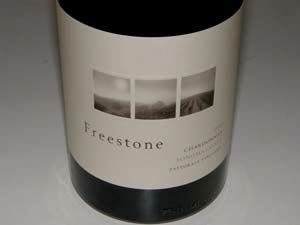 2008 Freestone Pastorale Vineyard Sonoma Coast Chardonnay 13.5% alc., 50 cases, $100. Before pressing, the whole grape clusters were lightly crushed by stomping on the grapes in the bins to liberate some grape solids and facilitate the extraction process during pressing. After native yeast fermentation, the wine was aged 16 months in a large oak puncheon, with bi-monthly bâtonnage. · Light golden, clear straw color in the glass. Needs some coaxing to open in the glass, but over time offers an alluring perfume of apple pandowdy, Asian pear and buttered toast. Similar in flavor profile to the Sonoma Coast bottling, but with added notes of roasted nuts, minerals and lemon zest. A sneaky wine that picks up intensity and interest with swirling in the glass and provides a full-on explosion of flavor after 30 minutes. A subtle creaminess and hi-tone acidity add to the appeal. Worth the tab for serious Chardonnay aficionados and in the same class as other top producers of Chardonnay in California such as Peter Michael, Kistler, Littorai, Hanzell and Ramey.
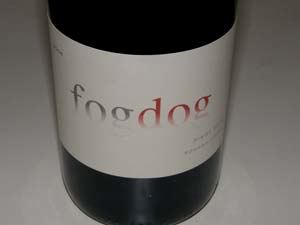 2008 Fogdog Sonoma Coast Pinot Noir 13.5% alc., 8,000 cases, $35. A blend of fruit from all three of the Freestone estate vineyards. · Moderate reddish-purple color in the glass. Highly perfumed out of the bottle with bright aromas of black cherries, berry jam, rose petals, spice, caramel and toast. Achieves more aromatic interest over time in the glass. Hi-tone and moderately intense blueberry, raspberry and cranberry fruit flavors with notes of pomegranate, framed by bright acidity. Still sporting dusty, dry tannins that will integrate over time. A solid daily drinker that will work beautifully at the dinner table for the next few years. A wine to buy by the case for the Holidays. Very good.
2008 Freestone Quarter Moon Vineyard Sonoma Coast Pinot Noir 13.5% alc., 120 cases, $120. For winemaker Theresa Heredia, this is one of the most naturally made wines she has produced. Picked at 23.5º brix with a minimal acid addition. The wine was 100% whole cluster fermented in an oak tank. 80% new oak. · A cornucopia of bright berry aromas is highlighted with scents of alluring exotic spice, sweet pipe tobacco and toasted oak. The purple fruit flavors are vivid and high-strung, fueled by vibrant acidity with toasted oak playing a background role. Noticeable tannins provide good structure, and the overall experience improves with time in the glass. Very impressive the next day from a previously opened bottle with more expressive fruit in the nose, and ramped-up fruit flavor. A special occasion wine.
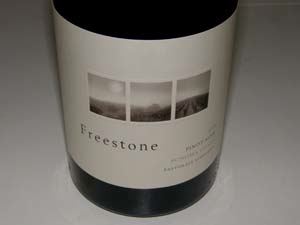 2008 Freestone Pastorale Vineyard Sonoma Coast Pinot Noir 14.4% alc., 143 cases, $100. · Moderate reddish-purple color in the glass. Great nose indicating something serious is to follow. A chameleon of a wine that changes constantly in the glass. Aromas of black cherries, exotic spices including cardamom, red rose petals and the slightest sweet oak. You would need to empty your entire spice cabinet into a bin of grape juice to duplicate the complex nuances and mysteries in this wine. The core is a mix of berries and stone fruits with an edgy, sauvage character from the whole cluster. Brisk and bright, satiny in the mouth, this wine is flat-out great. Tasted over the next two days from an opened and re-corked bottle, the wine held forth its allure indicating a long life ahead. A connoisseur’s Pinot Noir.
Goldeneye WineryAnderson Valley, CaliforniaThe Duckhorn Wine Company purchased the former Obester Winery in Anderson Valley in 1997 and planted 57 acres of Pinot Noir (Confluence Vineyard). The premier vintage of Anderson Valley Pinot Noir was 2001. Later they added other Anderson Valley properties including The Narrows Vineyard, Gowan Creek Vineyard and Split Rail Vineyard, and, also farm 20 acres of Chardonnay. Goldeneye now has a total of 207 acres in the valley, second only to Roederer Estate’s 580 acres. A new LEED certified production facility at Gowen Creek Vineyard was open in time for the 2009 vintage. The new winery and expanded vineyards have allowed the winery to increase production, but the overriding theme is still quality-focused wines and a small winery mindset. The new winery and Gowen Creek Vineyard are pictured below.
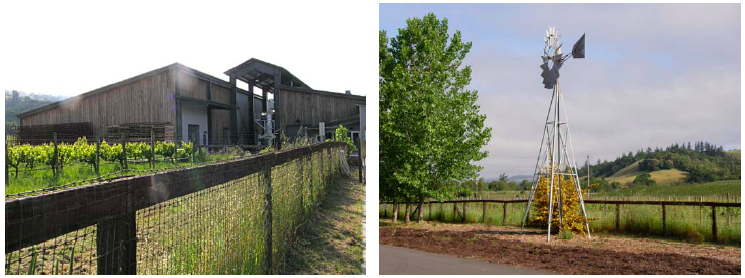 Goldeneye (named for a yellow-eyed waterfowl that occasionally calls Anderson Valley home since the region lies in the bird’s migratory path) sources fruit from both estate and non-estate vineyards, a total of twelve different vineyards. The lineup of wines include Goldeneye (a blend of all vineyard sources in the Anderson Valley) and Goldeneye single vineyard estate and reserve Pinot Noirs. A lesser-priced, but quality second label, Migration, composed of declassified juice from the Anderson Valley, was offered previously. This is now a separate winery under the direction of winemaker Neil Bernardi featuring Chardonnay and Pinot Noir from multiple cool-climate winegrowing regions. In 2008, Migration produced its first Chardonnay from the Russian River Valley, representing the first Chardonnay in Duckhorn Wine Company’s 30-year history. A companion wine, a Migration Anderson Valley Pinot Noir is also offered. A value-priced Anderson Valley Pinot Noir is also produced under a third Duckhorn Wine Company label, Decoy. The Goldeneye winemaker, Zach Rasmuson, apprenticed with Warren Winiarski, the founder of Stag’s Leap Wine Cellars. Intrigued by the challenge of producing Pinot Noir, he left Stag’s Leap in 1998 to become assistant winemaker at Robert Sinskey Vineyards. In May 2000, he was hired as winemaker of Husch Vineyards in the Anderson Valley, finally joining Goldeneye as winemaker in August of 2003. Owner Dan Duckhorn looks for a big, richly fruited style of Pinot Noir and Rasmuson delivers. The latest releases are voluptuous wines that deliver plenty of power, but are displaying more nuance compared to previous vintages. Rasmuson says, “2007 was one of those special vintages where the wines seemed to effortlessly reflect their vineyard origins.” The estate program offers 96 individual blocks of Pinot Noir and 49 unique combinations of clone and rootstock material. Though spanning only eight miles, the vineyards often display a temperature difference of as much as 10 degrees Fahrenheit. As a result, in 2007, PInot Noir was harvested over a seven week period and over 170 individual fermentations were carried out producing 1,200 barrels of wine. The favorite ten barrels, chosen for their extraction, ripeness and weight from Gowan Creek, Confluence and The Narrows vineyards, went into the Goldeneye Ten Degrees bottling. It is the most rich and powerful Pinot Noir produced at Goldeneye. Goldeneye wines are sold through a mailing list with widespread distribution of the Goldeneye Pinot Noir. The single vineyard and special bottlings are sold through the tasting room and to mailing list members. A comfortable visitor center and tasting room is open daily 11-4 on Highway 128 in Philo. An outdoor area with the Confluence Vineyard in the background is perfect for picnics and relaxing. Special vineyard tours and tastings are available by appointment (800-208-0438). The website is www.goldeneyewinery.com. Beyond the wines reviewed here, Goldeneye offers the Anderson Valley Pinot Noir, an Estate Grown Confluence Vineyard Lower Bench Pinot Noir, an Estate Grown Confluence Vineyard Hillside Pinot Noir, and an Estate Grown Gowan Creek Vineyard PInot Noir (previously reviewed - www.princeofpinot.com/winery/562/).
2007 Goldeneye The Narrows Vineyard Estate Grown Anderson Valley Pinot Noir 14.5% alc., 506 cases, $75. The coolest estate vineyard, planted in 1991 and situated on a narrow ridge top in the northern end of the Anderson Valley. This is typically the last-picked and lowest-yielding property. The majority of this wine is from block 20, planted to a mix of Pommard and Dijon clones, a section that the producers are particularly fond of. · Moderately dark reddish-purple color in the glass. Brooding aromas of black cherries and oak bark. Rich with concentrated ripe, sweet darker fruits which have some charm but are buried in tannins now. Impressively smooth on the palate. This wine will appeal to fans of full-bodied Pinot Noir and would make a perfect transition wine for an ex-Cabernet drinker. A good cellar candidate. Very Good.
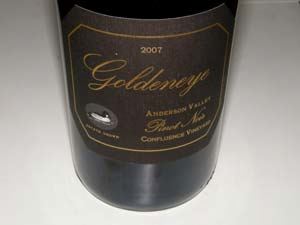 2007 Goldeneye Confluence Vineyard Estate Grown Anderson Valley Pinot Noir 14.5% alc., 516 cases, $75. This vineyard is located in the heart of the Anderson Valley at the headwaters of the Navarro River and displays a range of soils and exposures. · Moderately garnet in color in the glass. Amazingly aromatic with a potpourri of cherries, brioche and sandalwood. Delicious red cherry and raspberry flavors accented with spice and restrained oak. Not all about fruit, with some edgy earthiness adding character. Mild dry, suede tannins make for easy drinking now. The lightest in weight of the four vineyard based wines and the most charming now. A great expression of Anderson Valley Pinot Noir.
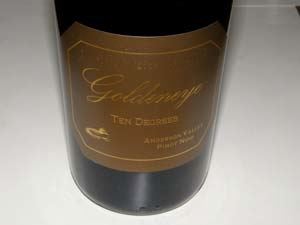 2007 Goldeneye Ten Degrees Estate Grown Anderson Valley Pinot Noir 14.5% alc., 222 cases, $100. · Moderately dark reddish-purple color in the glass. Very hard to coax much out of the nose after opening. The next day the wine had taken on much more aromatic interest with scents of berry jam, cassis and spiced plums. A robust, deeply flavored, tannic wine that has a good lift of complimentary acidity to bring everything into balance. Much better tasting over time in the glass and spectacular the next day where a stunning fruit core arrives at the forefront. This is not a wine for the timid, but for those who yearn for this hedonistic style, this is your Holy Grail. Definitely decant this wine if you open it now.
Williams SelyemRussian River Valley, Sonoma County, California The story of this fabled winery has been well-chronicled in the pages of the PinotFile over the years. In 1997, businessperson John Dyson bought the Williams Selyem Winery from Burt Williams and Ed Selyem, who were among the first garagiste Pinot Noir producers in Sonoma County. Bob Cabral was hired as winemaker, a 28,000 square foot winery and hospitality center opened on Westside Road in 2010, new estate vineyards (they now own 70 acres) were acquired or planted, new vineyard sources were obtained, and the Williams Selyem flag remains flying high. Annual production has gradually increased to over 14,000 cases and prices have crept up but quality remains top notch. Cabral (photo below) has gradually found his footing since his arrival as he has gained familiarity with the winery’s vineyard sources, backing off on alcohol and fruit extraction in favor of more charming and nuanced Pinot Noirs. 40% of production is estate grown. The winery produces a variety of blended and vineyard-designated Pinot Noirs as well as Chardonnays and Zinfandels.
 Williams Selyem wines are sold exclusively through a large mailing list of faithful customers. In the last year or two, small amounts of wine have been made available to those not on the list who call to purchase. Once a purchaser buys at least one bottle, they become a friend of the winery, stay on the mailing list, and have access to the winery’s hospitality center and tasting room which is not open to the public. Friends of the winery may also enjoy tours of the property and have access to some of the small production wines only available at the winery. The winery website is www.williamsselyem.com. Along with the 2008 vintage Pinot Noirs reviewed here, two additional wines were included in the last issue in a feature on the Middle Reach sub-region of the Russian River Valley and I have added them here again for completeness. I loved the 2007 vintage Pinot Noirs from Williams Selyem and found the 2008 vintage wines more inconsistent in quality, but some bottlings are first rate. Beyond the wines reviewed below, the following were offered in 2008: Westside Road Neighbors, Flax Vineyard, Peay Vineyard, Weir Vineyard, Ferrington Vineyard, Coastlands Vineyard, Hirsch Vineyard, Litton Estate Vineyard, and Precious Mountain Vineyard. Appellation wines included: Central Coast, Sonoma County, Sonoma Coast and Russian River Valley.
2008 Williams Selyem Vista Verde Vineyard San Benito County Pinot Noir 14.1% alc., pH 3.49, $54. Released fall 2010. This heavy limestone vineyard is located near Hollister in the Central Coast. Clones are Calera, Canada and Pommard. Aged 18 months in 70% new and 30% 1-year-old French oak barrels. · Intriguing aromas of dark red fruits, plum sauce, rose petals and oak. An individualistic wine sporting bright acidity to bring the berry and red plum fruit to life. A subtle spice cake component adds interest. Very smoothly textured with slippery tannins making for an easy and pleasurable drink. Good.
2008 Williams Selyem Bucher Vineyard Russian River Valley Pinot Noir 13.7% alc., pH 3.50 $54. Released fall 2010. This vineyard is located 1.5 miles north of Williams Selyem winery on Westside Road. Planted primarily to Dijon clones 667 and 777. Aged 17 months in 70% new and 40% 1-year-old French oak barrels. · Aromas of Bing cherries, tarry oak, spice and oil. A medium-weighted cherry-driven wine with an herbal oak and smoky underpinning that I find unpleasant. Soft and delicate, with fine dry tannins and a respectable grip of acidity on the finish. I suspect I got a bad bottle. Decent.
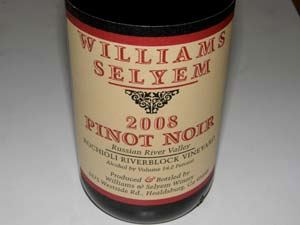 2008 Williams Selyem Rochioli Riverblock Russian River Valley Pinot Noir 14.2% alc., pH 3.49, $78. Released fall 2010. Aged 18 months in 70% new and 30% 1-year-old French oak barrels. · Moderately deep reddish-purple color in the glass. Brooding nose with reserved array of dark Pinot fruits. The following day, the wine had blossomed with considerable more aromatic interest including scents of ripe dark berries and currants, spice and cola. Luscious core of classy fruit enhanced by notes of brown spice and cherry cola. Smooth and appealing in the mouth with restrained fuzzy tannins and a lively acid lift on the intensely fruity finish. Much better tasting the next day with an impressive array of broad flavors that could only come from the Rochioli Vineyard. Hold this one for a few years in the cellar and then party on. Very good.
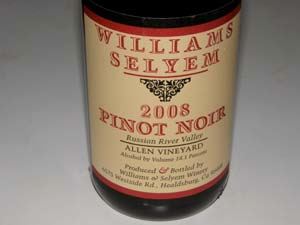 2008 Williams Selyem Allen Vineyard Russian River Valley Pinot Noir 14.1% alc., pH 3.50, $78 Released fall 2010. From a vineyard planted in the early 1970s. Aged 18 months in 60% new and 40% 1-year-old French oak barrels. · Moderately light reddish-purple hue in the glass. Shy, but very bracing aromas of red cherry and berry fruits with a hint of cut flowers and wintergreen. Flat-out delicious core of strawberry and black cherry cola flavors that saturate the mid-palate. Very smooth and sexy with a proper acid backbone to pitch the fruit. A seductive wine now, but needs more time to fully mature. All you can ask for in a Middle Reach Pinot Noir.
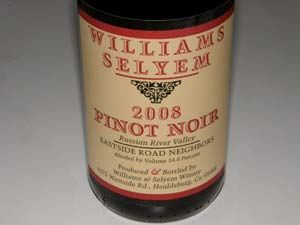 2008 Williams Selyem Eastside Road Neighbors Russian River Valley Pinot Noir 14.4% alc., pH 3.60, $49. Released fall 2010. Composed of fruit from vineyards located along Eastside Road including Calegari Vineyards, Black Rose Vineyard, Lone Oak Vineyard and Foss Vineyard. Aged 16 months in 65% new and 35% 1-year-old French oak barrels. · Moderate reddish-purple color in the glass. Wonderful aromatics flush with spicy cherries and strawberries. Delicious dark red fruits with nuances of Coca-Cola and spice, lingering on the finish. Very smooth and seductive in the mouth with enough tannic backbone to support longevity. No oak crops up to spoil the party. Very close to the old Williams Selyem style and a wine that speaks Middle Reach loudly.
Pinot BriefsDetails of Classic Wines Auction Announced Based in Portland, Oregon, First Growth Children and Family Charities is a nonprofit organization that produces the Oregon Classic Wines Auction. The 27th Annual Auction will be held February 28 through March 5, 2011, at the Oregon Convention Center. The program includes Taste Walla Walla, Spring Winemaker Dinners at 28 restaurants in Portland and SW Washington, the Ambassadors Dinner at the Portland Art Museum (Honorary Wine Ambassadors are Dennis Cakebread of Cakebread Cellars, Bill Hatcher of Rex Hill, Marc Perrin of Château de Beaucastel and Christophe Hedges of Hedges Family Estate. The Gala Auction on Saturday, March 5, 2011, features guest chefs Cory Schreiber and Adam Sappington. For tickets, visit www.classicwinesauction.com. RRV Winegrowers Presents a Wine & Cioppino Dinner On Saturday, March 5, 2011, a Russian River Valley Wine & Cioppino Dinner will be held in Grace Pavilion at the Sonoma County Fairgrounds. Tasting of RRV wines, crab cioppino dinner, music, silent auction and raffle. Tickets are $55 per person at www.rrvw.org. Rippon Vineyard Opens The Rippon Hall For several years, Nick Mills of Rippon Vineyard at Lake Wanaka in Central Otago, New Zealand, has hosted musical festivals. On January 23, 2011, The Rippon Hall will have its first live music concert featuring Warren Maxwell. Limited to 200 attendees, tickets are now on sale. Visit www.rippon.co.nz. The official opening ceremony will be on Saturday, January 22, 2011, including words from James Millton, ribbon cutting, tree planting, and guided tours of the building.
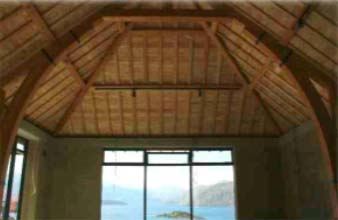
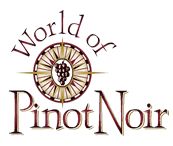 Gift the World of Pinot Noir Looking for a unique gift for a pinotphile? Consider a gift of WOPN at Shell Beach, California, March 4-6, 2011. The tickets can be mailed to you with a gift card or sent directly to your gift recipient with a personalized note. To purchase, visit www.wopn.com, select the WOPN Store tab, and for each ticket you order, enter the name of the recipient and the word “Gift.” After completing your order, send an email to info@wopn.com with your instructions on where to send the tickets, your text for a personalized note, etc. You can also order by phone: 805-489-1758. Fundraiser for Oral Cancer Foundation at Estate in Sonoma John Kelly, winemaker at Westwood Winery, informed me of an event on December 18, 2010, at Estate Restaurant in Sonoma. Sondra Bernstein has opened her restaurant for the event, providing tasty edibles. Kelly will be pouring Westwood wines and representatives from Tesla Motors will be there to give guests rides in the new Tesla Roadster 2.5. For more information: www.westwoodwine.com/Electrifying
 Noble Rot Attracts Millenial Wine Drinkers The Noble Rot is a mobile wine tasting saloon. So far, offbeat wine tasting education events have been set up in New York City in private spaces such as Manhattan rooftops and lofts. Entertainers and chefs are invited. The whole idea is to shed pomposity and pretension and make learning about wine enjoyable. Jonathan Cristaldi and Brian Quinn, both in their late 20s, who head up The Noble Rot, offer a millennial's view of wine enjoyment. Events are planned for Los Angeles and California. Visit www.thenoblerot for information. The Noble Rot Blog is at www.winetology.com. West Sonoma Vintners Unite The newly formed West Sonoma Coast Vintners Association (WSCV) consists of founding wineries Failla, Freeman, Freestone Vineyards, Peay and Red Car. The WSCV was formed to protect the history, landscape and culture of the West Sonoma Coast and promote the wines, vineyards and culture of the region to media, trade and public. A website is planned and the group will coordinate and promote sub-appellations to the TTB, media, industry and consumers. A yearly event is planned in Occidental on the weekend of August 5-7. Another West Sonoma County group, West Sonoma County Wineries, consists of 10 members within 10 miles: Balletto, Dutton Estate-Sebastopol Vineyards, Dutton-Goldfield Winery, Freestone Vineyards, Graton Ridge Cellars, Hanna Winery, Iron Horse, Marimar Estate, Russian River Vineyards, and Taft St. Winery. This group all have tasting rooms and are co-marketing quarterly tasting room specific events. Check Out Grape Radio There are several good recent podcasts posted in which I participated. Check them out at www.graperadio.com: “The 2010 World of Pinot Noir,” “20 Years of Williams Selyem - Parts 1 and 2,” “The Wines of C.P. Lin of Mountford Estate in New Zealand,” and “Tasting 2008 Oregon Pinot Noir.”
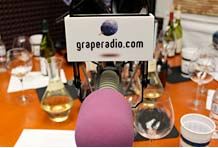 Days of Affordable Burgundy May Be Near an End Decanter.com reported that record prices were paid at the annual Hospices of Beaune auction. This is a bit surprising considering that the 2010 vintage in Burgundy is very uneven. The event organizers are interested in establishing Burgundy interest in Asia and Asia had more registered bidders than the United States. Asian buyers accounted for 12.5% of total sales. Many lots exceeded prices for the 2005 vintage. The small amount of top Burgundy wine produced will surely become more inflated in price as competition for the wines heats up as wealthy Asians entering the fray.
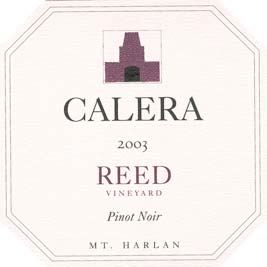 Josh Jensen Reveals Startling Facts In the latest newsletter from Calera, Josh Jensen wrote to his mailing list shortly before leaving for a sales trip to Tokyo and South Korea. He noted that Calera sells to about 25 “entities” abroad and for the first 10 months of this year, they accounted for an incredible 42.7% of total sales. Last year, in 2009, they accounted for 40% of sales. Calera’s biggest export market by far is Japan. Much of the sales success in Japan can be traced to 1996 when a major Japanese adult newspaper ran a strip called The Sommelier and featured Calera Pinot Noir. Lou Foppiano Turns 100 Iconic winemaker, Louis J. Foppiano, celebrated his 100th birthday last month at a party held at the Healdsburg Golf Club. Foppiano Vineyards is Sonoma County’s oldest continuously operated family winery. Probably the most famous historical event in Foppiano’s career is preserved in memory by a photograph in the tasting room dating to 1926, when during Prohibition, federal authorities forced young Foppiano and his family to dump 100,000 gallons of red wine into a ditch along Old Redwood Highway. The winery’s signature wine has been Petite Sirah. Recently a new winemaker has been hired, the winery facility upgraded, and modern viticultural methods instituted in the vineyards. New Winemaker at Pfendler Vineyards John Raytek, who has his own label, Ceritas, and has worked as an assistant at Flowers, Copain and Rhys Vineyards, has assumed the winemaking role for Pfendler Vineyards beginning with the 2010 vintage. ¡Salud! Oregon Pinot Noir Auction Raises Over $650,000 Proceeds from the annual ¡Salud! Oregon Pinot Noir Auction increased 7% over 2009. The money raised covers essential medical care for thousands of seasonal vineyard workers and their families. Held November 12 and 13, 2010, at Domaine Drouhin Oregon and Portland’s historic Governor Hotel, the auction included unique 2009 Pinot Noirs from the 42 “Vintners Circle” of top Oregon wineries. The ¡Salud! Oregon Pinot Noir Auction will celebrate its 20th Anniversary on November 11 and 12, 2011. For more information, visit www.saludauction.org. New Releases of Note 2008 Domaine Drouhin Oregon Willamette Valley Pinot Noir and 2007 Domaine Drouhin Oregon Lauréne Pinot Noir. 2007 The Eyrie Vineyards Original Vines Reserve Pinot Noir, 2008 The Eyrie Vineyards Estate Pinot Noir, 2009 The Eyrie Vineyards Original Vines Reserve Chardonnay. 2008 Dusky Goose Dundee Hills Pinot Noir. 2009 Et Fille Kalita Vineyard, Maresh Vineyard Pinot Noirs. 2009 Red Car The Aphorist (Bartolomei Vineyard), Dreamland (Platt Vineyard) and Heaven & Earth (Bohemian Station Vineyard) Sonoma Coast Pinot Noirs. The new Red Car tasting room in Sebastopol at the corner of Gravenstein Highway and Graton Road is now open by appointment, with regular hours to come. Next door is the new Dutton-Goldfield tasting room pouring their new releases of 2008 Freestone Hill and 2008 Devil’s Gulch Pinot Noir. Dutton-Goldfield is offering magnums of their wines for the holidays. 2008 Bonaccorsi Sta. Rita Hills and Santa Barbara County Pinot Noirs, 2007 Bonaccorsi Melville Vineyard and Cargasacchi Vineyard Pinot Noirs.
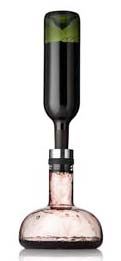 Winebreather Carafe From a Danish company, Creative Danes, headquartered in Carlsbad, California, the Winebreather carafe aerates wine quickly by channeling the wine through the carafe’s long neck and down the sides to the broad base of the carafe. The wine is thoroughly aerated in less than 2 minutes. Testing shows that after 2 minutes in the Winebreather, the young wine contains 740% more oxygen. This appears to be a very nifty way to decant and aerate wine at home. Simply press the decanter onto the top of an opened bottle of wine, and flip it over so the wine pours into the decanter. You can then serve the wine from the decanter or flip it back once it is aerated and pour the wine back into the bottle and serve it from the original bottle. The company makes plenty of other innovative wine and beverage use items. Visit www.creativedanes.com. Buy from www.winestuff.com for $69.99, with custom engraving available. South Willamette Wineries Association (SWWA) Wineries in Southern Oregon organized last year to promote this wine growing region and distinguish itself from the Willamette Valley AVA, which it has been lumped with since 1984. Although not an official distinction, many wine enthusiasts divide the Willamette Valley into northern and southern regions, the dividing line being the approximate latitude of Salem (approximately 45 degrees north latitude). Most of the 16 member wineries are within an easy drive of Eugene and include Pinot Noir producers Benton Lane Winery, Chateau Lorane, Domaine Meriwether (sparkling wines), High Pass Winery, Iris Vineyards, King Estate Winery, LaVelle Vineyards, Noble Estate, Pfeiffer, RainSong Vineyard, Saginaw Vineyard, Sarver, Shadow Mountain Vineyards, Sweet Cheeks Winery, Territorial Vineyards, Capitello Wines. Trip planning to this region is offered on the association’s website at www.southwillamettewineries.com. Oregon Wine History Project™ Students and faculty at Linfield College, the home of the annual International Pinot Noir Celebration, have begun to research Oregon’s wine history. Supported by a grant from the Erath Foundation, interviews have been conducted with wine pioneers Dick Erath, David Adelsheim, Diana Lett, Dick and Nancy Ponzi, Susan Sokol Blosser and Myron Redford. Their comments are part of an exhibit at Linfield’s new Center for the Northwest (www.digitalcommons.linfield.edu/wine_project/). The exhibit is open to visitors and includes videos devoted to “Sustainability and the Early Years of Oregon Wine,” “Oregon Wine: The Early Community,” and “Oregon Land Use Planning: Saving the Hills for the Vines.” SFMOMA Exhibit: “How Wine Became Modern: Design + Wine 1976 to Now The San Francisco Museum of Modern Art featured program now on display explores the visual culture of wine and its transformation over the last 30 years. The exhibition combines historical artifacts, architectural models, design objects, newly commissioned artworks, with a “smell wall,” a wall displaying the art of the wine label, and film screenings. On display are bottles of the two wines that won the 1976 “Judgment of Paris,” the 1973 Chateau Montelena Chardonnay and 1973 Stag’s Leap Wine Cellars Cabernet Sauvignon. Visitors are urged to bring used natural corks to SFMOMA’s exhibit for recycling and enter to win monthly prizes including a Grand Prize of a Northern California Luxury Wine Adventure. The Museum’s Store offers wine books, wine accessories and wine gifts. Visit www.sfmoma.org.
Wine Books to Savor and to GiftVertical Rex Pickett’s follow-up novel to his novel and film Sideways. Miles and Jack are back seven years later and headed on a journey that takes them to the International Pinot Noir Celebration in Oregon where Miles is the master of ceremonies. As good as the movie Sideways was (grossing $250 million), I enjoyed the book more and I plan to read Vertical over the holidays with a glass of great Pinot in hand, well before the proposed movie debuts. Buy the book at www.verticalthenovel.com (softcover, $15 including shipping).
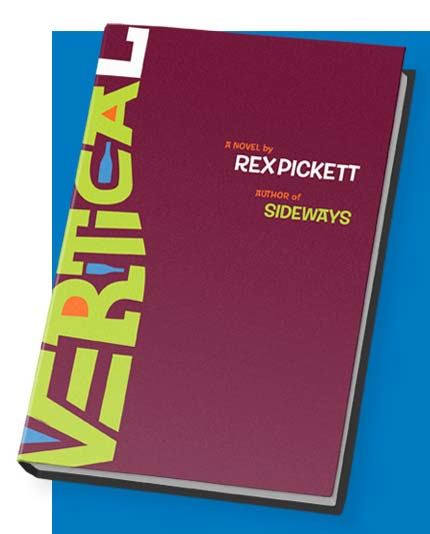 The Pearl of the Côte The Great Wines of Vosne-Romanée Allen Meadows is a highly respected authority on Burgundy whose many years of scholarly devotion to the region have culminated in this highly acclaimed work. This very special 350 page book explores the most legendary region in Burgundy, covering the fascinating history and the terroir of each of Vosne’s grands and premier crus, brought to life with original modern maps, creative art work and beautiful photography. This is the ultimate gift for a Burgundy lover. Buy the book at www.burghoundbooks.com (hardcover, $59.99).
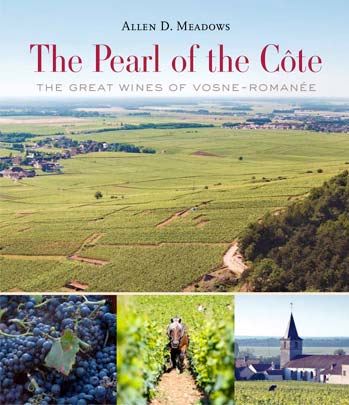 Inside Burgundy 30-year Burgundy resident and Master of Wine Jasper Morris has published a 656 page tome that is the definitive reference work on the vineyards, wines and producers of Burgundy. It is the most accurate and up to date work of its kind ever. Currently, it is not released in the United States (release is scheduled for next year), but can be ordered directly from the UK at www.bbr.com or the Athenaeum bookstore in Beaune at www.athenaeumfr.com. (hardcover, $84).
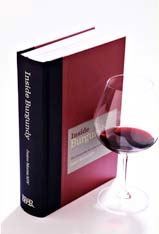 The Art and Design of Contemporary Wine Labels The author, Tanya Scholes, is a floral designer who worked in the advertising and design industry for years and gained an appreciation for graphic design, typography, photography, branding and packaging. Her beautiful 288 page 8.5” x 11” book is an illustrated survey of the labels produced by over two hundred international wineries. Interviews with winemakers and designers reveal the stories behind the four hundred labels included in the book. A history of label design is included as well. Several well-known North American Pinot Noir producers have labels featured including Antica Terra, Big Table Farm, Eric Kent Wine Cellars, Longboard Vineyards, Radio-Coteau, Red Car Wine, Road 31 Wine Co., Sine Qua Non, and Van Duzer Vineyards. Curiously, no Burgundy labels are included. Buy from www.santamonicapress.com (hardcover, $45).
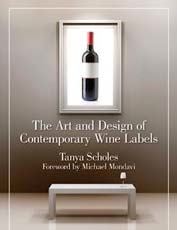 Wine Tasting Uncorked: Guided Tasting Courses and Tips Written by Michael Schuster, this is a series of cards that the wine novice will find very useful. The cards provide the basics of how to taste, observe, describe, evaluate and enjoy wine. The different major wine varietals are detailed. Tasting techniques are reviewed and a glossary of wine tasting terms is provided to learn and use. At the end, a series of cards detail a “Do-It-Yourself” wine tasting course that allows one to practice all the tasting techniques learned. The package is informative, succinct, unpretentious and practical. This is a great gift for your brother-in- law who seems to be stuck on Trader Joe’s Two Buck Chuck. Order from www.amazon.com or any book retailer (2010, $14.99).
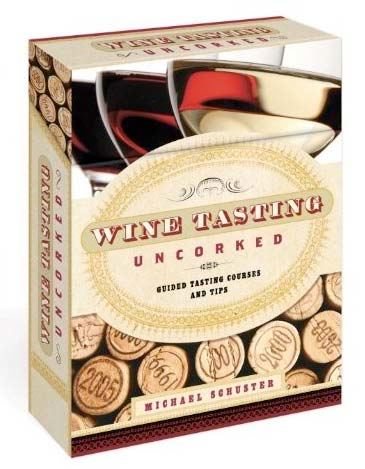
Pacific Pinot Noir: A Comprehensive Winery Guide for Consumers and Connoisseurs John Winthrop Haeger, University of California Press, 2008. Passion for Pinot: A Journey Through America’s Pinot Noir Country Written by Jordan McKay, photography by Robert Holmes and Andrea Johnson, Ten Speed Press, 2009.
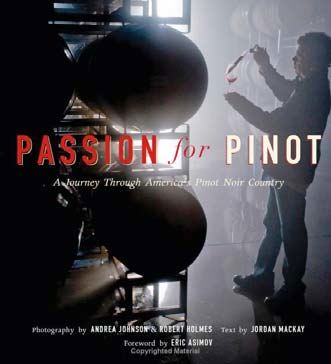 Wine Atlas of New Zealand Michael Cooper and John McDermott, Andrews McMeel Publishing, 2nd Edition, 2010. Essential Wines and Wineries of the Pacific Northwest Cole Danehower, photography by Andrea Johnson, Timber Press, 2010.
The Bucket List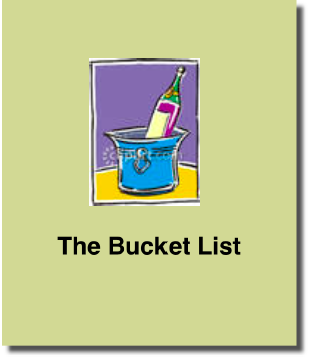
|
